![[Headline]](../../../technik/sonstige/headtran.gif)
![[Headline]](../../../technik/sonstige/headtran.gif)
The SPIEL '12 Games Convention |
|
As every year I had to wait until the fair finally opens for the public. So I could not join Frank doing all the playtesting and reporting during the past few days. But as I already had holidays, I did not pass my time useless, but picked over this year's novelties to prepare my days at the fair. I am quite sure that I found some jewels that I will try out during the next days. So I hope you still enjoy our coverage and that I can contribute to give you a rough overview about some really interesting games. My day began in a hurry. Because I moved to Essen two months ago, I saw no need to buy a pre-sale ticket for the fair. I thought this time I could spare the advance sale, because now my way to the fairground is very short. But when I reached the convention area, I nearly got a shock. People over people waiting to get a ticket. So it took me over half an hour before I could set a foot in the building. That stupid time of waiting made me almost miss my first appointment for today. In Hall 7, the last hall of the fair, a new hall that opened only for the second time at the SPIEL, waited the team of GOLDEN EGG GAMES for me. When I reached the booth, I only saw one game and a table. No copies to purchase. Due to a delivery problem the retail copies will arrive not before tomorrow. Many people came and asked about that, because the game I came for was quite a successful game at Kickstarter and those guys wanted to pick up their copy at the fair. Well, they must wait another day, but I was able to get an introduction and played some rounds to check out the game. This is how it works: Playtesting session: Fallen City of Karez (Golden Egg Games, Booth 7-115)GOLDEN EGG GAMES was established to create games with a strong thematic feeling and a high degree of strategy. Their newest game, Fallen City of Karez is a fantasy game which is orientated to a role-playing game. At a first look on the table I found heroes and monsters, but also a city with buildings under construction and private dungeons. Invited by the attractive design of the game, I sat down and let myself immerse in the Fallen City of Karez. 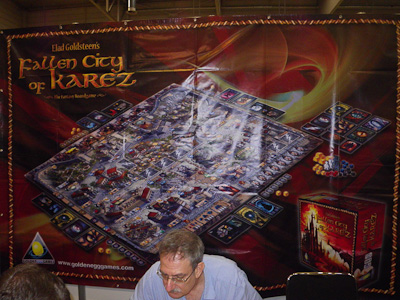 First thing I had to learn was that a player does not control a single hero in the game, but instead we are something like the masters of guilds that try to retake the fallen city from the evil for the heir of the dead king. As a reward for the most effective guild the heir has promised fabulous wealth (or so they say...). Each guild has a given special building on the main board. There you can also find other buildings that can be used by everyone and dungeons. At the beginning we are equipped with gold and an individual fixed number of monsters and heroes. Then we only have to shuffle the adventure decks and place a starting workforce, consisting of citizens and adventures, on the centre of the city before we can start the game. A turn begins with an action phase, in which we can use buildings to get new resources, weapons, monster and heroes, or we can go to the dungeons where our heroes fight against monsters. For most of these actions you need citizens or heroes from the general supply. Buildings that belong to our guild increase our power, because if other players want to use them royalties for this use must be paid. We can also build our private dungeon. Here we can get rid of incompetent adventurers from the general supply, again to get some bonuses. Other players can attack this dungeon and fight against our private monsters that we hold in our hands. Special buildings like the healer's tent or the cemetery complete the rich choice of available actions. The next phase belongs to our heroes if somebody sent them to go to one of the dungeons. In this phase they can show what they have really learnt. One or several heroes of a player can explore an dungeon together and here they are - what surprise - confronted with monsters or traps. For this encounter Fallen City of Karez uses quite interesting combat rules. Dice are used to determine the outcome, but different than usual, a high sum is not always the best result. Both, heroes and monsters, have given values of the dice at which they are wounded. So for example a Minotaur could survive two wounds, one with a value of 3 and of 4. So the hero must roll a 3 or 4 to add a wound and the monster does not die before both numbers where rolled. To make things easier, some heroes (and monsters, too) have fixed attacking values. The same applies to the defensive dice. As all dice from the heroes are rolled at once, a successful defence can also be used to prevent other heroes from being wounded. Traps are defused similarly. A victorious hero team brings their guild Treasure and Valor cubes, a failed adventure increases the threatening level in Karez by one. 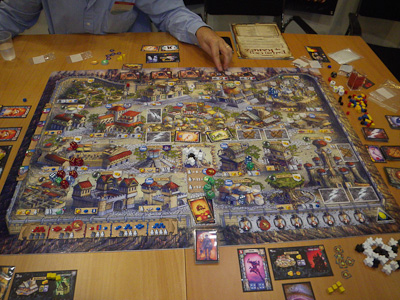 The threat level is monitored in the next phase. Only when the Valor exceeds the threat level considerably, Karez can become a real city again, whereas an overflow of the threat level may mean an early end for all the players' efforts. The game ends after the 10th round. I really liked hearing how Fallen City of Karez works. After two rounds of playtesting, I got used to the uncommon way of fighting and took delight in sending heroes to the adventures and the dungeons. The first part of the game seems to be a typical worker placement phase, but I think players should definitely have at least a small weakness for roleplaying games to fully like Fallen City of Karez. Antonis Papantoniou, the graphic designer will make it easier for all who did not grew up with a pencil, some paper and some strange sided dice like in D&D or other old roleplaying games. He really did a great job. Like in Drum Roll he gave the game a fabulous look, so you will not pass the booth (that is, if you find your way to Hall 7), without a second glance at the game, I am quite sure about it. After this promising start I had not to go much further to visit my next publisher for today. HELVETIA GAMES, also situated in the remote Hall 7, was only established this march. Their concept is to create all of their games with two sets of rules, one as a family variant and one for the geek player. Other than in comparable games they do not want the family rules to be a lighter version that is only the step short of the full rules, but both variants should work as complete games. Another concept of this publisher is to build all of their games around the mythical land of Helvetia, which has remarkable similarities to Switzerland. To the convention they came with their two games Helvetia cup, which is a soccer game, and Shafausa, a fantasy economic game. Today I will focus my coverage on the latter one, I come back to the other game on one of the next days. 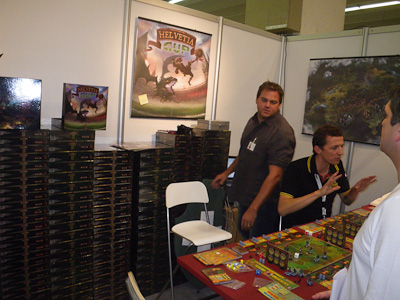 Playtesting session: Shafausa (Helvetia Games, Booth 7-104 )Switzerland seemed to be a multicultural state even in the good old days. How else could you explain that in the mythical land Shafausa you find up to 8 different races which compete for economic power. This all happened because the stubborn tribe of the Dwarves dug deep into the mountain and found gigantic caves, full off jewels and other valuable things. However, this immediately brought the race of the Vampires to the scene, who realised the great potential of this find. And so, bit by bit, a modern system of commodities markets was established and all tribes of Shafausa tried to take part in it. As already mentioned, all games from HELVETIA GAMES contain both a family and a geek variant. In the geek variant, a round begins with the production of resources. For that we all have our own player board where we can build mines and other buildings that produce or change the production rate of other houses. There are seven different resources available and for all of them an individual price is given for selling and purchasing at the commodities market. After the production a round of betting determines the order of play for this round. To be the first in a round has some advantages. On the one hand you are the first to choose new property from the available buildings in the next turn, and on the other hand you are also the first to change any speculations on the commodities market at the end of the turn. This also prevents other players to further change the rate of the same resource in that turn, so you can plan your next round in advance for at least one of the resources. After all players bought their new property, it is time for the management. In this phase we simultaneously can build and equip the new buildings and mines as well as freely buy and sell resources at the given prices from the commodities market. Resources that cannot be stocked in our warehouses must be sold, and after that the players in turn order can influence the commodities market for the next round. 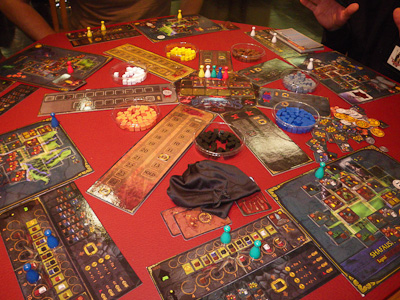 Both games from the new publisher HELVETIA GAMES really look great. A lot of excellent illustrated material gives Shafausa an unique look. However, apaprt from the graphic design also the economic manufacturing and the speculation at the commodities market seems to work quite well. Each tribe also has a special power and the challenge is to use this power best to win the game. This also gives each game an individual touch, depending on which races are participating in the game. If all new publishers come to the fair with such high quality games, I do not fear for the future. The only fear is, that you cannot decide which game you should buy. As I already said for GOLDEN EGG GAMES, if you have the chance to go the SPIEL, you should find your way to Hall 7 and attend the booth of HELVETIA GAMES, too. Having not seen much of the fair until now, I went for a stroll through the other halls after that. At the booth of ADLUNG I checked the novelties for games with my son. This took me nearly an hour, so I again was in a hurry to meet Frank. Together we went to REBEL where we were introduced to The Cave and Slavika. I will now present you the coverage about the latter one, Frank will do the same for The Cave. Playtesting session: Slavika (Rebel.pl, Booth 4-316)Slavika leads us into the mythical land of Slavic. We take the role of leaders of the ruling families, who are asked to protect the land and the inhabitants, until the daughter of the dead king had enough time to bind herself to the powerful amulet of Slavika. The family who does this best may send a son to marry the new ruler of the land. This sounded promising and after I already have retaken the Fallen City of Karez this morning this should be an easy task for me, shouldn't it? I think it should and so, equipped with a hand of six heroes and five monster cards, I once again marched into battle to fight all the scum of the earth. 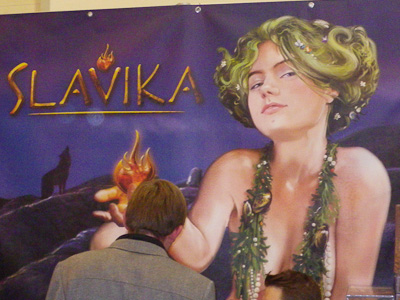 Slavika is a card game and so the four regions in which the fighting takes place are laid out as four region cards in the middle of the table. Under each of these cards we put a given number of treasure cards which will be awarded as a benefit for clearing the region of monsters. In my turn I have three actions in which I can send heroes to the one side and monsters to the other side of the regions. Each region card specifies the maximum number of heroes and monsters you can send there. My first two actions must be the sending of one or two heroes, if that is still possible, and the third the sending of a monster. All cards must be put to different regions, so it is not possible to provide the same region with heroes and monsters in one round (so I cannot send my heroes the best of my own suitable monsters). Whenever a region is full (when the maximum number of monsters has arrived), it comes to a battle. For this the strength of all monsters is compared with the strength of the heroes. Both heroes and monsters have a lot of special abilities. For example the Ranger can be exchanged with a hero that was sent to the region in an earlier round and a Wily cancels all special abilities of the heroes in a region. So it is always possible to change the balance of power with the last card, even if one side seems to be the sure winner. If the heroes are successful, the glory and the treasure cards are divided between the heroes, depending on their relative strength. Most glory is given to the player owning the strongest hero, but again this can be altered by the special actions of heroes and monsters. However, if the monsters win, the region is cleared from all heroes and monster cards and new treasure cards are put under the region card additionally to the cards that already did lie under it. So the region becomes more and more profitable. 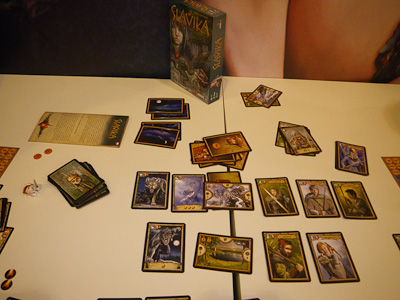 Slavika uses some mechanisms that are known from other games, but it puts these in a fresh new form. The special abilities provide the game with a lot of tactical possibilities. For example in our round it came quite often to a loss of the heroes, because one of the players, who had not sent a hero to a specific region, tried to prevent this region to be scored. Combined with the fantastic look, I think Slavika should be worth a try-out for fantasy orientated card game fans. The game can be played in about 30 minutes, but an unexperienced player will need much longer, because you must remember and understand all of the special abilities. I think Slavika gets all the better, the more players know the game. So check my review in the coming months to get an idea how it feels for an experienced player. With this I ended my playtesting for today, but I already saw many more promising games, so stay tuned and see you again tomorrow... |
Thank you Ralf for this first report!
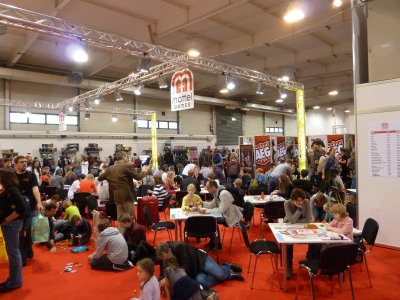
Having finished my lunch, I returned from home in order to meet with some friends from Cologne who come to the show each year in order to find some new games. We met in Hall 12, and they asked me whether I could point them to any game in special. However, with the schools having fall holidays this week, it was rather crowded in the convention halls, and so my friends were lucky to get four sets for a round of City of Horror which was played on an enlarged demonstration gameboard.
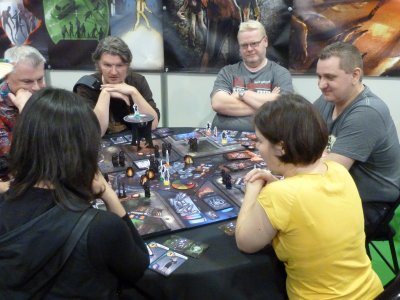
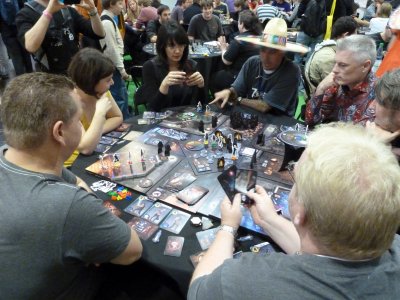
Myself, I had my next playtesting session of the day scheduled at the booth of CZECH GAMES EDITION, but instead of the awaited introduction to Tzolk'in: The Mayan Calendar I was recommended to have a look at Golins Inc., another of CGE's releases here at the SPIEL '12. Author Filip Neduk already was waiting for me, and since I had somehow missed this game during my preparations for the SPIEL I was curious how this surprise would turn out for me!
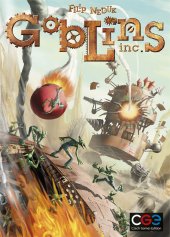 As it seems, Goblins must be quite fond of tinkering, and the strange company of Goblins Inc. has specialized in the production of Giant Robots of Doom. After many successful years the CEO now is going to retire, and his position will be given to the gobbo (player) who is most successful in building Giant Robots and turning them against the machines of his opponent.
As it seems, Goblins must be quite fond of tinkering, and the strange company of Goblins Inc. has specialized in the production of Giant Robots of Doom. After many successful years the CEO now is going to retire, and his position will be given to the gobbo (player) who is most successful in building Giant Robots and turning them against the machines of his opponent.
The game is played over several rounds in which the players build robots and turn them on in order to fight each other. To build the robots, the players have to draft building tiles which then are placed onto a square construction sheet. Quite similar to Galaxy Trucker, the different tiles may contain weapons, interconnection parts, shields and motors, but instead of crazily drawing and placing tiles each player just draws five tiles, places three and hands the other tiles to his opposing player. Thus, the robots slowly grow until they fill the whole construction sheet, with the exception that some spaces always have to be left free, depending on a design restriction card which is drawn at the beginning of the round.
With the design phase being over, the Robots are turned on and set against each other. The combat once again is fought over several rounds, and at the beginning of each round of combat each player chooses secretly which side of his robot he will turn towards the robot of his opponent, with the number of motors still intact limiting the possible number of rotations. With a second indicator the player also chooses which side of the opponent's robot he will attack, and so the first big element of speculation in the game concerns the question how the opposing player possibly may turn his robot. Usually it may be suspected that a player will turn his robot in a way so that most weapon tiles point towards the opposing robot, but since this behaviour might be expected it may just be wiser to turn a side with less weapons to the front, just to make the other player attack a side which has better armour.
Another element of speculation concerns three combat cards which are revealed each round. Each player secretly chooses one of the three cards, and during the upcoming combat round he may use the special abilities of this card to enhance his attack. However, if both players should have chosen the same card, the card will go to the player who has added most tiles with motors in his robot.
When the players have received their cards, each player rolls a number of dice corresponding to the number of weapon tiles on the side of their robot which is facing the other player and pointing towards his robot. One side of each dice is a miss, but the other five numbers indicate columns in which a hit is scored. Just like meteors or laser beams in Galaxy Trucker, a tile will be removed in this column, possibly resulting in the loss of several adjacent tiles if they loose their connection with the command room in the middle of the board. Here now the combat cards also may be used, and their special abilities may range from emergency re-rolls to homing devices which allow the changing of the result of one dice.

The combat continues for a fixed number of rounds, unless the command room is taken out by several hits which have killed all goblins in there. This actually will result in an earlier end, and if this should happen the winner of the combat will be assigned some bonus points for an early victory. The wrecks of both robots now will be evaluated, and this will be done by each player revealing a hand of Goal cards which I have not mentioned yet. At the beginning of a round of play each player is given seven Goal cards from which he may keep found and discard three. These cards list various conditions under which victory points can be scored, for example the destruction of certain tiles in the opposing robot. The Goal cards either may be defensive or offensive, with the offensive cards listing goals of destruction and the defensive cards listing tiles of construction which a player must try to keep intact within his own robot. As indicated, all Goal cards are revealed by the end of a combat, and each player scores victory points according to the accomplishment of his goals. With this evaluation the combat is over, and the game continues with the players building yet another robot.
As indicated above, the playtesting session for this game came to me out of nowhere. However, I must confess that I would have missed a really entertaining gem, because both the theme and its implementation where done in a quite charming way. While the game certainly contains a certain factor of luck which comes to bear when the combat dice are rolled, the players retain a good degree of control over the implementation of the goals listed on their Goals cards. Thus, during the building phase a player knows which goals he will follow during this round, and so - if he has certain offensive goals - he may hand specific tiles to the other player which he must then include in his robot. Thus, good targets for reaching the goals are guaranteed! In addition, some possibilities to improve the result of a round of combat also are given by the combat cards, and here it may be wise to add some additional motor power to a robot, since a high number of motors may give access to a combat card even if both players have chosen the same card.
However, a good part of the fun which can be found in Goblins Inc. also comes from the high degree of speculation which comes to bear when the players try to predict the actions of each other, both concerning the robot's rotation and the choice of the weapon card. Here cries of joy regularly will be accompanied by some moaning, and so the game contains a certain degree of chaos which fittingly can be attributed to the Goblin builders!
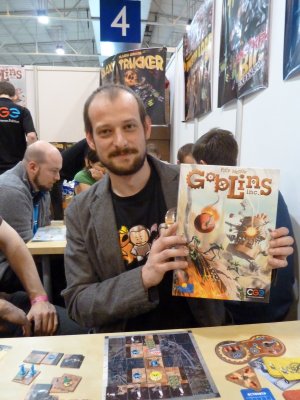
Talking about chaos, the game can be played with four players as well, but even in this constellation only two robots are used!. Now two players must build and operate a robot together as a team, with one player operating the facing of the robot and its weapons, whereas the other determines the choice of the combat card and is responsible for the combat. However, both players in a team actually possess their own Goal cards which remain hidden from the other team member, and this actually may result in quite opposing views how to best attack the opposing machine. What a crazy constellation, and what a great game!!! Author Filip Neduk really can be proud of it!
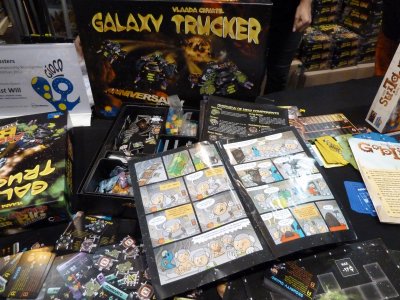
Being at the CGE booth, I was also able to catch a glance of the Galaxy Trucker Anniversary Edition which contains the basic game and its two expansions. As a special bonus, the game contains some additional cards and a comic-book featuring those delightful truckers. However, only the comic book is exclusive to this combo-pack, and so the bonus cards will be give as a promo item for players who purchase the new expansion Galaxy Trucker - Another BIG Expansion here at the SPIEL. By the way - something for the fans in Germany. As Petr Murmak from CGE told me, a German edition of the Anniversary Edition will be done by HEIDELBERGER!
This brings me to my last playtesting session today, and luckily the booth of REBEL.PL was not situated far away from CGE. I teamed up with Ralf, and together we entered the depths of The Cave.
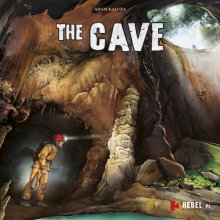 Polish game author Adam Kaluza seems to have a liking for extreme sports, because he has not only lead us players on a dangerous trip up the slopes of K2, but now he takes us onto a journey into the depths below earth's surface. Thus, The Cave sees the players take the role of speleologists (wow, I have learned a new word!) who have found an undiscovered cave, and each player now tries to find the most spectacular locations and passages in order to score most victory points.
Polish game author Adam Kaluza seems to have a liking for extreme sports, because he has not only lead us players on a dangerous trip up the slopes of K2, but now he takes us onto a journey into the depths below earth's surface. Thus, The Cave sees the players take the role of speleologists (wow, I have learned a new word!) who have found an undiscovered cave, and each player now tries to find the most spectacular locations and passages in order to score most victory points.
When the game is over, the players will receive victory points for photos of spectacular rock formations, for managing to cope with difficult sections where a traverse line has to be used or where the passage gets narrow, for exploring subterranean lakes and for reaching the really deep parts of the cave. Thus, they will collect tokens for performing these deeds during the course of the game, and the player who has collected the most valuable tokens will be declared to be the winner.
All players start with their team pawn being placed at a big base board where the base camp of all players is located. This board features several exits, and during the whole game the players may spend some of their action points allowance to reveal new Cave tiles and place them adjacent to an exit, provided there still is an unexplored exit available on the tile where their team pawn is currently located. Reminding me a bit of classic Dungeonquest, these square Cave tiles are drawn at random, but in order to give the game some structure the tiles do not come from one big deck, but instead the tiles are split into four decks which are shuffled separately. Depending on the number of participating players, some tiles from each deck were randomly discarded, and then the first deck will be used for the first phase of cave exploration. Only when the current deck of Cave tiles has been fully used up the next deck will become available, and by this means Adam Kaluza retained some control which Cave tiles will become available in the course of the game.
Some rules also must be followed when a new tile is placed, and most important here is the fact that a newly placed tile must match with the exists of all already placed adjacent tiles. If this condition cannot be met, the newly drawn tile is discarded and instead a generic boulder choke tile is placed, meaning that the player has run into a dead end. In addition, on some tiles tokens for the scoring of victory points are placed, and these tokens may be collected by a player who first succeeds in entering the tile with the equipment needed to claim the token. Thus, a token featuring an underground wonder only can be claimed if the player is in possession of a camera, whereas a lake needs oxygen for its exploration and the claiming of its token.
Some of the cave tiles also may feature a descent, and as a rule a descent means that all further tiles now are 25 meters deeper than the tile which led to the descent. The new depth will be marked with a corresponding depth marker, and a player may claim a corresponding depth token whenever he was able to reach a new depth with his team pawn. However, once again going deeper requires special kind of equipment, and so each 25 meters of depth which need to be climbed require the use of one rope.
The players choose their equipment at the beginning of the game when they may pack the eight available slots of their backpack with equipment of their choice. They can choose between a foldable raft, a camera, oxygen flasks and lengths of rope, but they will also need some slots where they will store food rations. Food is important in the game because each player has to spend one food token each turn to keep his team strong and mobile, and so only a team which has been nourished may spend this turn's five action points for different actions. If a team must remain hungry because it has run out of food, the player must use his whole turn just to move the his team pawn to the next adjacent tile, thus going stepwise back to the base camp where the backpack may be re-packed and new rations may be taken.
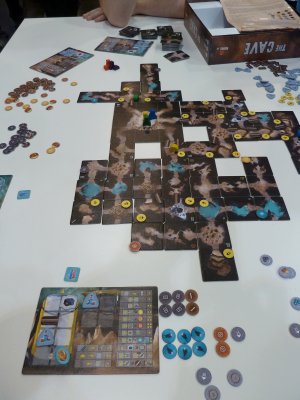
As indicated, the players reveal new Cave tiles and move their pawns on a mechanism based on action points, and during his turn a player will need to balance which actions he wants to take. Some actions even consume more than one action point (like the exploration of a lake which takes two points, or the squeezing through a narrow passage which may take up to four action points depending on the type of passage discovered). Thus, the main tactical element of The Cave lies in the relation between food and actions, because a player needs to calculate carefully whether he should still continue his current trip, or whether he should return to the base camp in order to re-stock with rations. As most victory point tokens may be claimed only by the first player who enters a tile, there is always a bit of pressure on the players, and so they will sometimes feel compelled to push further even though food is running low. However, as the game bears no random element of surprise apart from the revealing of the Cave tiles, careful calculation usually will help to solve all tight situations.
Quite interesting is the not yet mentioned option of the players to add a mobile camp to their backpack. This camp takes two packing slots, but it contains four additional packing slots in which even more equipment may be stored. However, this equipment only may be accessed when the mobile camp has been mounted, and this once again takes some action points. However, by use of this camp the players may extend their range of operations, and it may even pay off to spend some action points for moving back and forth between the base camp and the mobile camp, thus transferring additional rations and other equipment from the base camp to the mobile camp in order to maintain a well-stocked outpost deep in the cave.
Some additional competition is felt by the players due to the fact that bonus victor points will be rewarded to players who collected most victory point tokens in each category (lake exploration, photography etc.), and so the players get an even higher incentive to beat other teams to certain Cave tiles. This competition will deepen when the players have gotten familiar with the composition of the different decks of Cave tiles, because this will enable them to speculate which tiles still may appear and whether their lead in certain categories is still in danger.
As can be seen, The Cave is absolutely no dungeon-type game where the players roll dice and face unknown dangers, but instead it's a brainteaser which requires distinct calculation skills. There exist some games where such a pronounced element of calculation leads to a considerable slowing of the gameflow, but this problem is reduced in The Cave by the fact that the players only can spend up to five action points each turn and by the stepwise discovery of new cave tiles. Calculating a way through already discovered parts of the cave where all victory point tokens have been removed goes much quicker than might be expected, and so the players mainly need to focus on new tiles and their contents.
Once again Adam Kaluza has not only managed to create a new game on an unusual topic, but he also succeeded in creating a convincing set of rules which gives the players a quite interesting challenge. The Cave is absolutely no "underground-clone" of K2, but instead the game operates on a rather different set of mechanisms, drawing the players into the arduous but rewarding task of becoming successful speleologists (I love this word) right from the beginning!
I am already feeling a bit exhausted after this first day of the show and all this typing, but would a SPIEL be complete without a printable special goodie from Kulkmann's Gamebox?
It's good tradition that a selfmade downloadable mini-expansion for a game is presented each year during my SPIEL-coverage, and this year I was able get something really outstanding. After last year's SPIEL I discovered a new Kickstarter-project, and this time it was Ryan Laukat's game Empires of the Void. I was instantly taken by the great, comic-like artwork and the interesting sounding rules which promised a new take on classic space-opera games. Thus, I was all ready to join the group of Kickstarters when I discovered that Ryan has sponsored one copy of the game for the 2011 charity auction of the Jack Vasel Memorial Fund. Organized as a list at Boardgamegeek, many people had donated gaming stuff to be auctioned in favour of the Fund, and so people were bidding on different types of objects and rewards, ranging from small promo-expansions to big boardgame-bundles or oddities like a whole day out in New York (gaming evening included).
The specialty of the copy of Empires of the Void offered for auction there was the fact that the winning bidder would not only receive a copy of the game, but also be allowed to design a new race for the game, and Ryan had promised that he would draw a fitting picture for this race and create a player tableau which would then be available for download for all players of Empires of the Void. For me, this offer meant an irresistible temptation, since my long-term readers will know that I always loved to create small mini-expansions for great boardgames. And now such an opportunity was coupled with the promise that fitting artwork would be created, and for me this meant that I simply had to win this auction! So, being located in Germany I ended up booting my computer at 5:30 AM on a monday morning, since the bidding phase for all auctions was ending at 12:00 PM Eastern time. Fighting a sniper-duel with another bidder in the last minute of the auction, the game secured a great contribution to the Jack Vasel Fund, and I ended up with the opportunity to personalize my own copy of Empires of the Void which was due to arrive about half a year later.
And now, coming as this year's convention giveaway of Kulkmann's Gamebox, the new race is ready. As promised, Ryan has drawn me a beautiful player tableau featuring the new race, and he also designed a new planet token to go along with it. And that's just the item which I will present to you today: Planet Belshar!
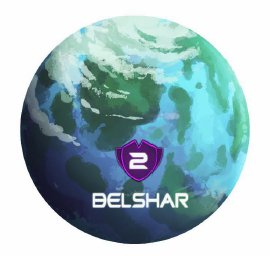
More about this mysterious planet will follow soon! My pile of games next to my desk is already growing, at the moment our cat Kira is impatiently waiting for me to turn off the computer. I better do so!!!
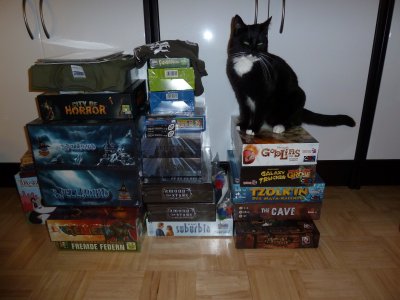
Hello again, and welcome back to another day full of exciting boardgames news right from the SPIEL convention!!!
Phew, this day was rather long, and due to the unusual warm weather outside, the air in the seems to be even thicker than in previous years. I still remember a few years ago a SPIEL with similar weather conditions, and during that time the Messe actually opened the big rolling gates into the courtyard. It would have been nice if they had done the same today, but unfortunately it did not happen.
Anyhow, the day was nonetheless packed with interesting events, and so let's start with a playtesting session which I had been looking forwards to for quite some time.
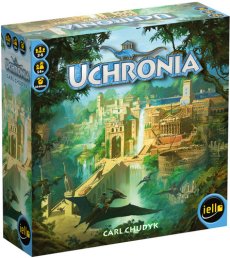 Once upon a time humans and dinosaurs lived together peacefully in the jungle city of Uchronia, and the great families of this civilization were competing to increase the glory of their kingdom by erecting ever more magnificent buildings and their city. This is the scenario chosen for Uchronia, and as might be guessed it will be up to the players to take the position of the noble houses of Uchronia to join in the competition to be the most successful house in the kingdom…
Once upon a time humans and dinosaurs lived together peacefully in the jungle city of Uchronia, and the great families of this civilization were competing to increase the glory of their kingdom by erecting ever more magnificent buildings and their city. This is the scenario chosen for Uchronia, and as might be guessed it will be up to the players to take the position of the noble houses of Uchronia to join in the competition to be the most successful house in the kingdom…
The buildings for the city are available in the form of cards. Each building has a number printed above its illustration, and this number represents both the number of resources needed to build it and the number of victory points it is worth once it has been built. The type of resources needed is specified by the building's colour, and so the buildings come in a total of five different colours, thus representing the five different types of resources available in the game. In addition, each building possesses a special effect which can be used by its owner when the building is completed, and as usual for such a mechanism based on buildable enhancements the special effects range from the generation of additional victory points to the possibility to perform a special kind of action. Thus, the players usually will try to finish buildings fitting to their general strategy in order to maximize their score of victory points.
However, as the background story of Uchronia focuses on the construction of these new buildings, the central part of the game is made up by an interesting resource-management mechanism which focuses on multiple uses of the resource cards available in the game. Unlike games like San Juan or Race for the Galaxy where the multiple functions of cards stem from the possibility to use them for building, as resources or for paying, all available functions of Uchronia resource cards are printed on the cards. So, the central part of each resource card shows an action, whereas the lower part of the card shows a resource and the upper part shows an action enhancing effect. But let's look at this with a bit more detail.

Usually the players will use the resource cards in their hand for triggering the action shown in the middle part of the card, and one possible action is the production of new resources. If a resource is produced, the active player is allowed to take one new resource card from an open display of resource cards (the "Forum") in the middle of the table, and this resource card then is placed below the player's playing mat so that only the lower part of the card with the resource on it is visible (thus representing the resource printed on the card). Likewise, another possible action to gain resources is exploring, but in contrast to production the resource card gained from exploring does not come from the Forum, but instead it must come from the player's hand.
Resources can be used for the construction of buildings, and a choice of new buildings is available from a common display on the table. If a player goes for construction, he may either chosen one of the buildings on display to start a building project, or he may move one resource from beneath his playing mat under one of his yet unfinished buildings, provided the resource matches the colour of the building. If enough resources have been moved under the building to equal its costs/value, the building is considered to be finished. Now its special function becomes available and the resources used for that building are discarded.
A second possibility for using resources is to go for trading. Here the upper part of the resources cards comes into play, since this action allows a player to change the positioning of a resource card beneath his playing mat so that now - instead of the resource on the lower part - the action enhancing effect on the upper part of the card becomes visible. From this point onwards the player will be able to perform the action shown with a higher efficiency, so that - for example - more resources can be produced or more resources can be used for construction. As a rule, each additional action enhancing effect increases the efficiency of the corresponding action by one degree, and the only limit to this is that a player never may have more action enhancing effects than is current total of finished buildings plus two. And, as a nice addition, the usage of resources to get action enhancing effects also lets the players go for a monopoly in each of the five effect-categories. The monopolies are an additional possibility to go for the amount of victory points needed to win the game.
This generally outlines the basic routine on which Uchronia operates, but the game is further enriched by a few additional rules which make the management of a player's resource cards even tougher. Thus, the Forum from where newly produced resources are taken is not replenished by randomly drawn cards, but instead the cards used by the players for triggering their actions will go into the forum. If a player should run out of useful cards, he also is allowed to abstain from performing an action for the whole round, and instead he may replenish his hand of resource cards to a total of five cards (or draw just one additional card if his hand already consists of 5 or more cards).
A bit of direct player interaction is caused by the fifth possible type of actions - the deployment of the Draconian Guard. A player who goes for this action reveals one resource card from his hand, and all players who have performed an action during their last turn must give the active player one card of this type from their hand (provided they have a matching resource card). In addition, the player also gains one matching card from the forum, and all gained cards now will be placed as resources beneath the player's playing mat. Like all other actions, the Draconians action also can be enhanced by an action enhancing effect, and in this case the active player can reveal additional cards from his hand, gaining him more cards from the Forum and forcing the other players to hand over a card matching one of the card types shown (thus broadening the chance to get a card).
During the first rounds the players face a moderate entry barrier because they first have to come to terms with the interrelation of the use of action cards and the "feeding" of the Forum, but once the rules have been grasped the threefold use of the resource cards is rather charming. As indicated earlier, here the game is both similar but also different to other games with multiple card uses, since the actions and their associated effects are unlike the card effects available in the aforementioned games.
Uchronia is one of these games which picks up speed quickly but ends too early. Well, it only ends too early from the perspective a player who wants to see his domain to prosper to perfection. Just like Race for the Galaxy challenges the players not to lose too much time on fancy projects, Uchronia rewards those players who keep their focus on efficiency and situational tactics. This gives the game a short-term orientation which is entertaining and addictive at the same time.
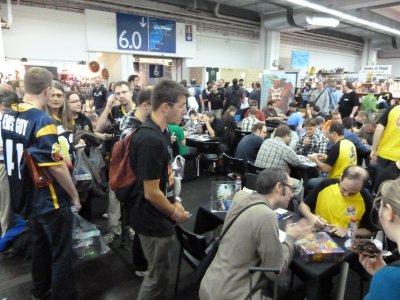
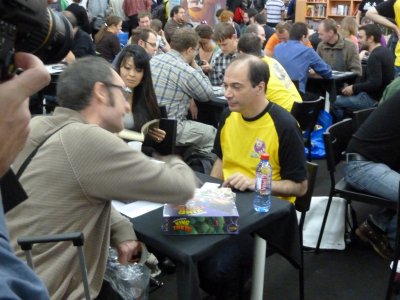
This first playtesting session took well after 11 AM, and shortly before that time a long queue of people was slowly building up in front of the IELLO-booth. All of them were waiting for the arrival of Richard Garfield, the designer of King of Tokyo, since he was giving out a very special promo-item for the game. In fact, he brought a stack of gamecards with just an image but a blank space for text, and Richard would put into this space a text describing whatever special ability this card was wanted to have. As it seems, this was a great idea!

As you might have noticed above, one additional game has been added to the prize draw! I am stuck with Goblins this year, and after yesterday's battle of robots at Goblins Inc., today's gobbos are forced by their Master to learn the intricate business of bomb-building. So, the cardgame Big Badaboom is rather explosive, and the people of the Swedish publisher GIGANTOSKOP sponsored one copy of the game to explode right here at the Gamebox!
I was next heading for the main restaurant in Hall 11 because I wanted to see whether some members of the International Gamers Awards jury would turn up for our annual lunch here at the SPIEL. However, I was abig early and so I went over to the booth of ADLUNG which is located directly opposite the restaurant's entry.
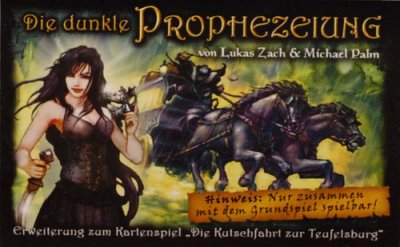
Some of you might remember my report from the SPIEL '06, and there I featured a quite interesting cardgame called Die Kutschfahrt zur Teufelsburg, featuring a sinister group of travellers which was sitting in a coach headed for Devil's Castle. The players in this game are split into two groups, but at the beginning of the game no one knows each other's identity. This could only be found out in a stepwise process by exchanging pieces of luggage or by combat, and it was the target of each group to claim possession of three specific cards of luggage, and openly announce that the group has succeeded in getting these cards. The game is rather popular amongst talkative gaming groups who like this kind of group experience, and all those year I have been waiting for an expansion to be released.
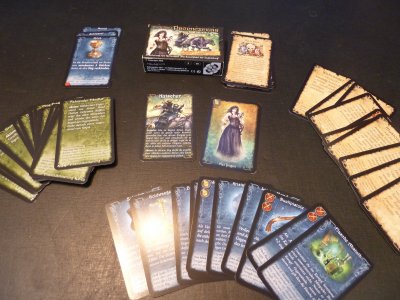
Now, six years later, my wish finally has become true, since the newly released cardset Die Dunkle Prophezeihung expands the game in several ways. So, the set features new professions for the travellers, new luggage cards and even one new traveller, but even more impact is felt due to the variant rules for the traitor and the coachman. The function of the coachman is taken over by one of the players, and his position may change as the result of a combat. It is one of the duties to turn over a card from a special event deck whenever his turn begins, and each of these Coachman event cards describes certain effects which may effect the travellers. However, this deck of event cards also functions as a countdown, starting with "sunset" cards, going through the night until finally the "sunrise" card appears. If no victorious group has yet been found, the game now will be over, and - if played with an uneven number of players - this means that the game may be won by the traitor, a player character who does not belong to the two groups of travellers. Due to the possibly visible wear marks of the aligment cards from the old basic game, the new set contains a new set of alignment cards in addition to the Traitor card. So this new cards cannot be told apart from any other alignment card! All in all, this seems to be a quite interesting set containing quite innovative add-ons for the game.
With me attending the IGA-lunch, the time seems to be right to check what Ralf has been doing all day!
|
Hello there again! Second day, same procedure as last day: I was in a hurry. This time I already had my ticket, but I had an appointment at 10 o' clock and because the doors only opens at that time, I had to rush into the halls to arrive in time. Lucky enough the booth of ARES GAMES is not far away from the entrance... With Azlán of the famous author Leo Colovini the Italian publisher ARES GAMES publishes his first Euro game that is also suitable for families. Formerly known for publishing the great War of the Ring and the miniature game Wings of Glory, ARES GAMES now strikes a new path. And they do it well, if I was not totally fooled by my first playtesting session.... Playtesting session: Aztlán (Ares Games, Booth 12-42 )In the game up to four players try to prosper their tribe in the mythical land of Aztlán. Combat is possible and sometimes also necessary, but for winning the game, a peaceful coexistence is sometimes the better choice. The board shows us a circular part of the land Aztlán, divided into 30 territories and consisting of five different types of terrain. The game lasts five rounds, called ages in the game. Every turn, the players get a specific amount of tribe pawns to place on the board. At the beginning the sum of the pawns is quite high, but with progressing ages (rounds) the available new tribe pawns are decreasing, corresponding with the populating land. Each round the players freely place, one at a time, one of their tribe pawns on the map. There is no limit of pawns in one land, and you can also put your pawns to territories where other players have pawns, too. Additionally after placing a new pawn onto the board, a player may also move one of his other pawns for one step. 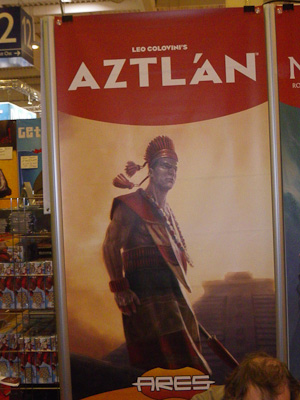 Soon the land of Aztlán becomes very crowded and - meant or not - pawns of different tribe end up on the same regions on the map. Then we - as the leaders of the tribes - have to decide whether we want to battle against the other tribes or try to coexistence. If it comes to a battle, the power of each tribe is determined by the number of their pawns in that region multiplied with the value of a power card that we had played at the beginning of the round. So you always have to plan in advance, because the power card determines your total power in a fight in a large part. The winner of a battle always removes all of his opponent's tribe pawns from that territory. But there is another possibility for the strongest player in a region. He may choose to coexist with the other tribes. This can individually decided for each territory in which it comes to a conflict. Both decisions have their advantages. In case of a battle, the winner can claim more land for himself and prevent other players to expand their territory. On the other hand, whenever a player chooses to coexist he is given a prosperity card that can be used to positively influence the later game for the player, in most cases it is good for the victory points. At the end of each round, victory points are given to the players. For each domain, that is a series of adjacent regions in which the player has at least one of his tribe pawns, he calculates his victory points. He is given one point for each territory in this domain plus a bonus equal to the number of territories that match the chosen power card. This is the second function of the power card which was played at the beginning of the round, so it is extremely important to use the right power card for the individual situation. 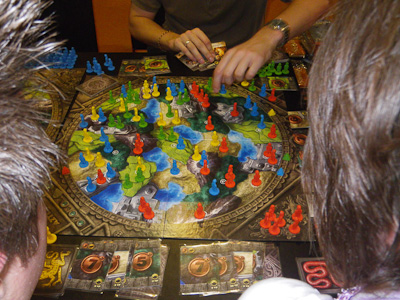 Although Atzlán is very easy to learn, I think that it develops a remarkable level of strategy. The choosing of the right power card for a round seems to be somewhat like the secret to success. So I think that Atzlán is much more than a simple family game. I would even guess that it has at least the potential to win the one or other prize as game of the year because of its quite catchy playing mechanism and the nice graphical implementation. So like last day I had a very promising start. I decided to continue with another attractive-looking game, this time from the German publisher ARGENTUM. Playtesting session: Desperados (Argentum, Booth 5-64)Over the last years the German publisher ARGENTUM has provided us with a lot of excellent strategy games like Wind River or Hansa Teutonica. This year's novelty is called Desperados and it is explained as a cooperative Wild Western game by the publisher. Well, cooperative it is, but only for a part of the players. One player must "sacrifice himself for the cause" and takes the role of the Marshal. All other players are Desperados who shorten their time as card sharpers, highwaymen and bank robbers and of course by fleeing from the Marshal and his sheriffs. In my testing round I was assigned the role of a Desperado, so I had the cooperative part and could come to agreements with my fellow players about where to rob the next bank and other important things. The board gives us a map of a part of the Wild Wild West. Cities are connected with roads and this also determines our possible ways to move from one place to another. Randomly drawn schedules show us the way the stage coaches travel, quite useful if you want to waylay them...After every player has chosen a starting point for his figures - the Marshal and the Sheriffs, who also belong to the Marshal, and the Desperados. The Marshal's player always starts the round. First he moves the stage coaches as given by the schedule. After that he may move all of his Sheriffs (one for each Desperado) to an adjacent city. Then he moves the Marshal, but he does so hidden from the other players. How does this work? Do you remember Scotland Yard? I was strongly reminded of this classical game when I tried Desperados. Well, the Marshal player just plays the movement card of his destination city from his deck and places it face down on the table. 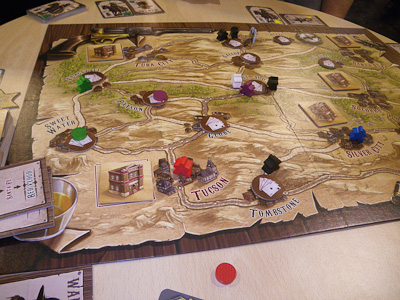 The same applies for the movement of the Desperados. To cooperate it is allowed to talk but also to show each other the next destination one wants to move to. But why should I cooperate with the other players. The reason for this are the Sheriffs who walk around and are an obstacle to the misdoings of the Desperados. Only when there are more Desperados than Sheriffs in a city, they are allowed to cheat and rob the stage coaches. If a Desperado wants to take part in such an activity, he must proof that he really is in the city. So the Marshal's player knows where he should be more present in the next turns to come. But taking part in lawless activities does not automatically ensure success. The Desperados have to wait until the examination phase which begins after the fifth movement phase. Only then the result of the search of the Marshal player and the success of the activities of the other players are revealed. In this phase the movements of all players are reconstructed step by step on the board (by disclosing their cards successively). Desperados who are in the same town as the Marshal are immediately arrested. Their turn is over and they have to hand the city card in which they were caught to the Marshal player, meaning that they no longer can go to this city for the rest of the game. Also their arrest could influence the activities planned by the Outlaws. Only if there are still enough Desperados left and not arrested, the indicated activity can happen. The game ends after the fifth round and is won by the Desperados onl if they were able to "collect" more than 4000 Dollars per player. Once again ARGENTUM has published a very good game. Adopting partially the old Scotland Yard mechanism of covert movement, author Florian Racky developed a fast paced and entertaining new game. Our testing round took about one hour including the explanation, so it should always be possible to change sides and take revenge. I suppose the game is all the better the more player are in the game. Our 4 player round was OK, but more Desperados (up to 6 players are allowed) would have done the game even better. I will try this constellation out during the coming weeks, but I am almost certain that it will be loved by a lot of people. After these two more or less family games, I was in the mood for a real challenge. Something complex and tactical. That was the reason why I immediately thought about Michele Quondam. Michele is one of my favourite game authors of the last years. His games are always perfectly elaborated. Sometimes they are complex like Rio de la Plata, sometimes they are reduced to the minimum like last year's The Forgotten Planet. This year's novelty, Gladiatori, is one of the complex ones and is about - who could not guess it - gladiator fights. Two years ago I was also confronted by the theme with the debut game of ALBE PAVO. But Munera: Familia Gladiatoria was much more than just deciding how you can decapitate your opponents. A lot of the game was about the organizing of the games itself. And so I learned in that game that the gladiator fights were not just two slaves being put in an arena. To take part in a fight was seen as honourable and could bring the gladiator (and his manager) a lot of glory and money. So, when I heard that GIOCHIX.IT was publishing this new game of Michele, I was curious about how they would put the theme into a game. Playtesting session: Gladiatori (Giochix.it, Booth 5-53+95)Again I learned something new in Gladiatori about the gladiator fights: on some of the cards of the game I recognized female fighters. Asked whether this was right, I was confirmed that there were indeed some woman fighters acting as gladiators in ancient Rome. So the stronger sex was not so dominate in the Roman times as it seems to be. But now let us see how the game works… For the most part Gladiatori is a card game. But there is also an arena board that has an important function, too. On this board the fights take place. Michele Quondam's game is focussed on the fight and so we fill the arena with our gladiators, move around and see whose gladiator can reach his opponents with melee weapons, whose gladiator is attacked from behind and who blocks the way for a ranged weapon attack. So it is possible that several rounds pass with the players warily watching each other, before one of the players has the nerve to attack. For me, the arena played a big part in contributing to the right gladiatorial atmosphere. Too bad only that the producer of the game made a mistake and forgot to put the miniatures for the gladiators into the box. But I guess that this problem will soon be solved... 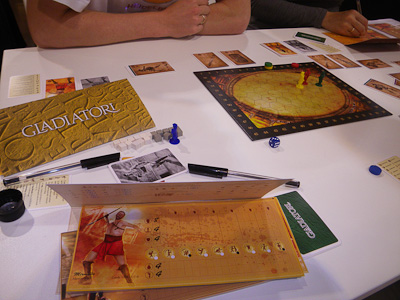 A "normal" game starts with the creation of your gladiator. Similar to the creation of a hero in a role play game, you can distribute a given number of points between your character skills, abilities, available energy cards and special moves. On the fair we started with pre-designed characters, something which could also be wise if you are unfamiliar with the game. At the beginning of the turn, we have to choose cards from our hand that we want to use in this round. There are actions, energy, special movement and feint cards in the game. A player can choose as many cards as he wants, but on the other hand all cards that were not chosen are added to our available hit points. Dare-devils might choose a great power for their actions, but I always tried to get a good balance, because without enough hit points, life may be quite short indeed. In the then following combat round, we can move our gladiators on the arena board and attack other players. An attack is always started with an action card. Each type of card has a different effect, so a strength action card must be distinguished from a dexterity action card. All attacks can be defended and again there are a lot of different possible reactions. Next to the bonus of the cards themselves you can alter the attacking or defending value with items, the value of your skills, an ally bonus, action versus reaction bonus and some other things. Sometimes it is also possible to play a feint card and send your opponent to the wrong track, spending a lot of his power for this feint. Some special moves or items can also alter your status, so that you can fall down or be trapped by the famous gladiator net. While creating your gladiator you also can learn special powers, for example to immediately stand up when you are trapped. You see combat is very complex, but that is exactly what makes the game so very realistic. I could continue to enumerate details of the game, but as I am not here for reciting the rulebook, so I think I better stop. Still I hope you got a rough idea about the game mechanism. If you have the chance to attend the fair you should take some time for trying the game. My first impression is that it is really a great game. Of course it is complex and you will use some time to get into the game. This might not please all players, but I think it should be possible to learn the game in about half an hour and then it seems to be a fantastic and realistic game of the gladiatorial fights. This is especially true since the game offers so many ways of alteration. For example there is the option to put additional animals into the arena. So you better try it out, I will do the same and will tell you about it in the next couple of weeks. After this heavy morning I met Frank to take some pictures of the awards ceremony of the International Gamers Awards. Frank will tell about this and I - for the first time at this year's SPIEL - had the chance to go for a walk and look for other games I could test in the next days. What I saw should be worthwhile, to stay tuned! I only hope that I will be able to catch the one or other table, because I have only one pre-arranged appointment left. And this one was also today in the evening, so I am standing here now as the normal visitor with the same problems in finding tables. But before I confront you with this problem on the next days let us see how my last appointment ran: Playtesting session: 1984 Animal Farm (Kuznia Gier, Booth 4-121)1984, the world after the time that the animals took over the control. The game 1984 Animal Farm of the Polish publisher KUZNIA GIER adopts some elements of the books of George Orwell. But this is only the background story. In reality we are confronted with a heavy negotiating game. The board shows us the world with five unstable regions where we try to pledge alliances with our opponents to retake the power and get the influence markers. Each region actually is ruled by one of the animal races like the cats in Latin America and the Kangaroos in Australia. Each race has its own influence markers that give the players special abilities once they conquered some of the influence markers. Each player represents the leader of one of the world powers and must sent his agents to get back influence in the different regions. For this they can place and move their agents from one region to another at the beginning of each round. With the special action from the influence marker of a cat a player can do another move. The next phase is the most important phase in the game. Region after region is treated and in each one the players must pledge temporary alliances to determine who has the strongest power at this region. So, for example, two weak players can decide to pledge an alliance to overcome the power of a third player. Nearly anything goes when forming the alliance. For example you can promise your fellow player to form an alliance with him in the next region, although you are already the strongest one. It is also allowed to advertise one's agents to the player who gives the best offer. But beware, there is no obligation to abide by this agreement. This results in a lot of communication in the game. The winning party takes from the influence markers of that region and divides their prize freely between the players (again this can result in a lot of negotiating). At any moment in the game, influence markers already won can be used for special actions to influence the game. Influence tokens - under certain conditions - can also be used to destroy other player's influence tokens. This action can be extremely important when it comes to the revolution phase. In this phase most of the scoring takes place. Between each pair of neighbours we find a revolution card. To start a revolution we have to place three given influence markers on the revolution card on our left or right side (or both of it). I does not matter if we or our neighbour do supply the revolution with the influence markers, so again this may create a lot of negotiating.  The first round of 1984 Animal Farm was a little bit frustrating for me, because I could not figure out whether the one or other move would do better for me. As a result, I was not a good partner for negotiating. But that changed rapidly in the second and third round. Once you understand how the game works, negotiating can be really interesting, especially with talkative persons. Treachery is allowed, but beware! You might find yourself standing alone, with no one trusting you any more. I think that the game should be worth a try-out as a light-weighted family game and for persons who like to negotiate and talk during a game. Once again, I will try to find out more during the next weeks to give you a full review... By the way: the crew from KUZNIA GIER also told me that the long-awaited Z-MAN version of Alcatraz - The Scapegoat soon will be ready. The game will hit the shelves before Christmas! So, this was it for me for today. Tomorrow I will be attending the fair with my son, so I will concentrate on so totally other games... |
Well, as you can see, Ralf had quite a busy day, but my own schedule was not really any shorter.
I next headed over to the booth of BOARDGAMEGEEK in Hall 12 where once again the awards ceremony for the International Gamers Awards was on the schedule. This The SPIEL is the one occasion during the year where at least a fair portion of our jury members comes together at one place, and since also most authors are attending the show it is our best option to present the awards right here at Essen!
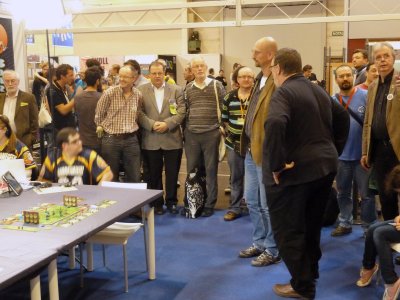
Standing in the back row you can see from right to left Knut Wolf, Andrea Ligabue, Ronald Hoekstra, Han Heidema, Ferdinand the Cassan, me and - just on the left - Stuart Dagger, whereas in the middle Stefan Feld, author of this year's winning game Trajan and Bernd Dietrich (AMMONIT SPIELE) were waiting for the ceremony.
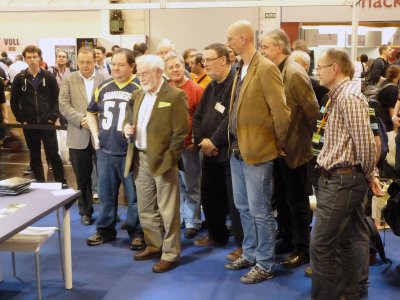
In absence of our chairman Greg Schloesser who had to stay at home in the United States, the awards once again was presented by Stuart Dagger. Even I had to play a minor role today, because Stefan Feld actually had asked me to serve as a translator, and so I did my best to reproduce his thanks to the jury for getting this awards. He said that he was really proud to get it, especially since it's an international awards which means that his game has been well received in quite a number of different countries.
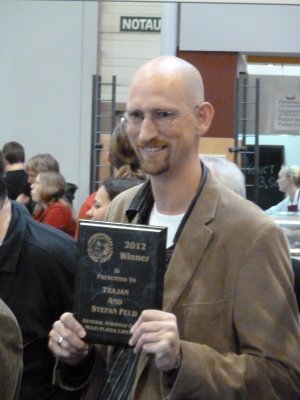

The awards in the category of multiplayer games was followed by the two-player awards, and this went to Uwe Rosenberg and publishers LOOKOUT SPIELE and Z-MAN GAMES for their new game Agricola: All creatures Big and Small. As some of you will know, Uwe Rosenberg seems to have subscribed to our awards, since he already won in the years 2008 and 2009 in the multiplayer category with his games Agricola and Le Havre.
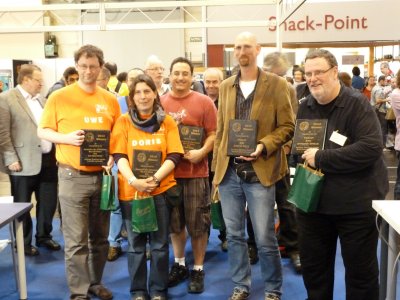
Once again congratulations to all winners for creating and publishing these great games!!!
It was already 3 PM when I left the booth of BOARDGAMEGEEK, and since I was in Hall 12 anyhow I just rounded two corners to go to the booth of DAYS OF WONDER where I hoped to get to play a new expansion for one of their most successful games. Indeed I was lucky, and so I sat down to enter the shifting worlds of Smallworld Realms.
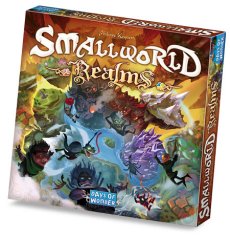 Quite opposite to the name of the game, the Smallworld-Universe is getting bigger and bigger! At the SPIEL convention 2011 DAYS OF WONDER released Smallworld Underground, and apart from the new subterranean gameboards and races this new game - if used together with the mini-expansion Smallworld Tunnels - for the first time opened up the possibility to play Smallworld with up to six players. Well, there has been the Necromancer-mini-expansion a year earlier which also allowed the inclusion of a sixth player, but since the role of the Necromancer was rather special many players were longing for a possibility to play a "normal" game of Smallworld with up to six participants. The combination of the gameboards from both base games made this possible, but now Philippe Keyaerts has thought of yet another, even more interesting possibility to accommodate up to six players in Smallworld!
Quite opposite to the name of the game, the Smallworld-Universe is getting bigger and bigger! At the SPIEL convention 2011 DAYS OF WONDER released Smallworld Underground, and apart from the new subterranean gameboards and races this new game - if used together with the mini-expansion Smallworld Tunnels - for the first time opened up the possibility to play Smallworld with up to six players. Well, there has been the Necromancer-mini-expansion a year earlier which also allowed the inclusion of a sixth player, but since the role of the Necromancer was rather special many players were longing for a possibility to play a "normal" game of Smallworld with up to six participants. The combination of the gameboards from both base games made this possible, but now Philippe Keyaerts has thought of yet another, even more interesting possibility to accommodate up to six players in Smallworld!
Unlike the previous boxes, the new Smallworld Realms set is no complete game, but instead it is a supplement both for Smallworld and Smallworld Underworld. The main feature of this new expansion set are 26 roughly hex-shaped terrain-tiles, and these tiles feature Smallworld-landscapes on the one side and Smallworld Underground-landscapes on the other. Together with a few additional markers for mountains, chasms, etc., these terrain tiles can be used by the players to build their very own gameboard, giving the players room to use their imagination for the creation of continental shapes and extra rules.
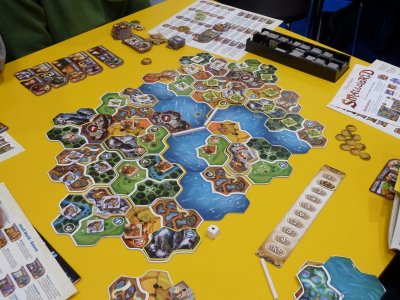
As can be seen, the key element of the expansion is the possibility to create a new world, and the big advantage of the terrain-tiles can be seen in their flexible number. In order to keep self-made scenarios balanced, a few hints for the creation of scenarios are given, and foremost comes the counsel that the world created by the players must remain small enough to create enough competition. Thus, it is easy to create a world which matches a general orientation value of nine regions (not terrain tiles) per player, and this value really proved well chosen to keep competition high. As indicated, the expansion set also features some additional tokens which can be used for the creation of special scenarios (just like the special places and artefacts in Smallworld Underground), but here Philippe Keyaerts suggests that new rules only should be used quite sparingly, since otherwise the game would face a danger to be overburdened and slow down by a complex body of rules.
Nonetheless, the creation of special scenarios is tempting, and to save the players the work to create a new world and fitting rules right from the beginning, the rulebook for Smallworld Realms features a total of 12 different scenarios which can be played right away. These scenarios are remarkable for a number of reasons, with the interesting new special rules connected with each scenario being only one of the positive aspects. For one, the whole presentation of each scenario is rather well structured, giving an indication on the scenario's complexity and the numbers of players which can participate. All scenarios can be adapted to different numbers of players, starting with small worlds suitable just for two players, and going to rather big creations for up to six players. The scenario instructions clearly display which terrain tiles are used, and which terrain tiles are removed if the scenario is played with less than the maximum amount of players.
The available scenarios carry for different kinds of tastes, including pure Smallworld or Smallworld Underground settings or a combination of both. Another feature is the quite interesting use of water in some scenarios, since one scenario features a world divided into different continents, whereas another scenario challenges the players to follow a world which is designed like a river. A quite special scenario also is "Adrift", and this specific world is not even fixed, but instead the continents (i.e. the terrain tiles) are constantly moving, thus changing the appearance of the whole world and the positioning of races among these tiles.
Each of these scenarios forces the players to think slightly different, and this alone guarantees many hours of renewed playing fun. To my mind the possibility to create variable worlds was just the last missing bit to give Smallworld the possibility to completely outdistance GAMES WORKSHOP's much older Kings & Things, a game which also was focused on the conflicts between eccentric races on a small but variable world. Even though the setup of a scenario and the explanation of the special rules takes slightly longer when using Smallworld Realms, the game has kept its elegance and easy accessibility. The players only profit by even more variety, and so this expansion can be welcomed with open arms!
However, the day was not yet over, and so I once again changed booths within Hall 12, this time going to a meeting I had scheduled with Fabien, the press representative of MATAGOT. I was especially interested to play the new big MATAGOT game Kemet, but with all tables being occupied I feared that I might miss the opportunity to do so. However, Fabien had a rather welcome solution to this, since he actually grabbed a game and together we left the convention halls and waked over to the ATLANTIC HOTEL which is directly opposite the convention entrance. Fabien was allowed to use a table there, and so I could give Kemet a thorough look in this comfortable atmosphere.
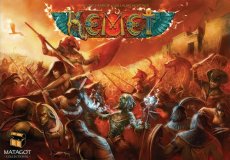 30 years ago conflict simulation games (cosims) were in high esteem with strategy gamers, and companies like SPI or AVALON HILL (before the HASBRO-takeover) created very complex games dealing with historical wars like WWII or the American Civil War, and sometimes they even approached sci-fi or fantasy topics like SPI's classic War of the Ring. Usually these games came with lots of small cardboard counters and huge rulebooks which featured many sub-paragraphs for dealing with different kinds of circumstances, and both learning and playing these games took much time than many modern gamer would be willing to invest. Games like MB's Axis and Allies were among the first to change the situation, featuring still long playing times but at least much shorter rules, and as it seems today the situation has turned around. There still exist a few complex and long running games like ARES' War of the Ring, but many more games have been published which follow the path of manageable rules and playing times. Among these games are Ryan Laukat's Empires of the Void or Cyclades by Bruno Catahala and Ludovic Maublanc, and as indicated these games share the common fact that they are much more accessible especially for new players.
30 years ago conflict simulation games (cosims) were in high esteem with strategy gamers, and companies like SPI or AVALON HILL (before the HASBRO-takeover) created very complex games dealing with historical wars like WWII or the American Civil War, and sometimes they even approached sci-fi or fantasy topics like SPI's classic War of the Ring. Usually these games came with lots of small cardboard counters and huge rulebooks which featured many sub-paragraphs for dealing with different kinds of circumstances, and both learning and playing these games took much time than many modern gamer would be willing to invest. Games like MB's Axis and Allies were among the first to change the situation, featuring still long playing times but at least much shorter rules, and as it seems today the situation has turned around. There still exist a few complex and long running games like ARES' War of the Ring, but many more games have been published which follow the path of manageable rules and playing times. Among these games are Ryan Laukat's Empires of the Void or Cyclades by Bruno Catahala and Ludovic Maublanc, and as indicated these games share the common fact that they are much more accessible especially for new players.
As demonstrated by Cyclades, especially the editorial crew of MATAGOT seems to have a good instinct for the refinement and publication of such modern cosims, and so they have decided to return to the SPIEL '12 with a new game which goes back even further into ancient history. With Kemet the two to five players are taken back to the times of Ancient Egypt, and in the Nile valley they battle for predominance which is expressed by the possession of victory points. Two different types of victory points exist in the game - temporary and permanent points. Temporary points can be gained by the occupation of regions containing temples or by building and defending pyramids of the highest level, whereas permanent points will be gained by attacking and winning battles, by the possession of certain Power tiles (representing the research of new "technologies"), by controlling two temples at the end of a round and by sacrificing units at a special location. The first player to win 10 victory points will win the favour of the gods and is declared the winner of the game.
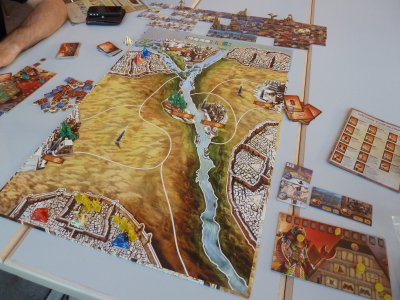
On first sight the set-up gameboard of Kemet might look like any other game of military conflict, with each player possessing his own city where his military units are placed, but closer scrutiny quickly will turn a player's eye to the fact that the regions on this gameboard are extraordinary large, thus resulting in very close distances between all regions and in a much higher degree of mobility which will be felt during the whole game. In fact, this alone forces players in Kemet to assume a quite aggressive stance, since the victory points needed to win the game cannot be gained by fortifying and hiding behind a player's city walls.
A round of play in Kemet is symbolized by the passing of a day and a night, with the night-time being the preparation phase in which the players gain new Prayer points (the game's currency) and Divine Intervention cards (used for one-time actions and effects), whereas the day is used by all players to perform their five possible actions. However, as a last step before the break of day the player order for the upcoming day is determined, and here Kemet follows the somewhat uncommon method that the player order is determined by the player with the fewest victory points. This is clearly due to the fact that the game needs to be balanced, because being the first or last player always can mean a certain advantage in games of military conflict, but the effect of this somewhat prejudiced decision by the weakest player is softened by the fact that the players only may perform one action before the next player takes a turn. So, during the day actions will alternate in player order until all players have had the chance to perform their fifth and final action.
The player actions may not simply be chosen by the players, but instead each player is given a player board which represents his faction and displays a pyramid where symbols for the different available actions are found. Each player has five action tokens, and whenever he choses an action he must cover the symbol of this type of action on his player board pyramid with one of these tokens. The different types of actions are available in different quantities, and as an additional rule the players must end the action phase with at least one action token being placed on each of the three levels of their player board pyramid. Thus, the players will face a stepwise narrowing of their range of available actions, and they must keep an eye on the development on the gameboard in order not to be taken by surprise without the availability of a fitting counter-action.
The available actions range from praying (more Prayer points) to the recruitment and moving of troops, but likewise important are the raising of pyramids and the acquiring of white, red and blue Power tiles. Each player possesses three differently coloured pyramid figures (which are in fact four-sided dice), and these pyramids may be built in the three quarters of a player's city. Whenever a player adds one or more levels to one of his pyramids by the payment of Prayer points, he adjusts the corresponding pyramid within his city so that the number standing for the pyramid's current level is shown on top. Apart from the fact that a level 4 pyramid grants its owner a temporary victory point, the pyramids have three different colours and for each of these colours a common display of Power tiles has been placed at the beginning of the game. The players may purchase such Power tiles, but only if their corresponding pyramid has reached a level which corresponds to the level of the Power tile. In a figurative sense the Power tiles represent new "technologies", and in accordance to the rule "the higher - the better" the high-level Power tiles will provide better benefits than low-level tiles.
The choice of available Power tiles is quite broad, but the players face the restriction that most Power tiles are unique so that they only can be purchased once. In addition, the few tiles that are available in higher numbers only may be acquired once, so that no player may possess a certain tile more than once. The special abilities of the Power tiles depend on their colour, and so the white tiles mainly deal with Prayer points and resources, the Blue tiles represent abilities for defense and control, and the red tiles give useful abilities for movement and attacking. Quite interesting also are the seven creatures which can be obtained via Power tiles, since they offer various improvements to the troops which they accompany on the gameboard. However, the broad choice of available Power tiles easily may distract a player from the main goal of obtaining victory points, and so it's quite tempting to concentrate on obtaining new powers and miss the fact that other players go for a quick victory. Thus, it's always important to keep an eye open for possibilities which might open up on the gameboard.
Talking about the situation on the gameboard, Kemet deals with the movement of units and the resolving of battles in a very straightforward way. At the beginning of the game a player may use one movement action to move one army of up to five units for one region, but the range of movement will increase if the player obtains Power tiles which give additional movement abilities. Quite interesting is the fact that the players also may pay Prayer points to use their pyramids as a gate to teleport an army to a region containing an obelisk symbol, and this is especially useful for reaching the temples in the Nile delta which are inaccessible by normal land movement.
Whenever the troops of two players meet, a battle will occur in which the strength values of both armies will be compared. The battle strength of an army is determined by the number of units, a bonus provided by a present creature and the player's Power tiles, eventual Divine Intervention cards played by each player and a Battle card which each player had to choose from a set of six Battle cards available to him. The player with the higher strength total wins the battle, and if it is the attacker he will gain a permanent victory point. Then the casualties will be determined by comparing the damage and protection values of the Battle cards chosen by each player, and each player must remove a corresponding number of units from his army. Two additional rules must be mentioned here, and the first is the fact that each player chooses not one but actually two Battle cards. The first card is used in the upcoming battle, whereas the second card is simply discarded. After the battle the used card is discarded as well, and during the next battle the player cannot use the discarded cards anymore. Only if all six Battle cards were used (after a total of three battles), the player receives his full hand of Battle cards back and may once again chose from his full range of cards. In addition, both the winner and the looser of a battle have the possibility to recall troops to their stockpile after the battle is over. By this the players will gain back Prayer points corresponding to the purchase value of these units, and so recalling troops effectively gives a player the possibility to remove an army which otherwise would be an easy pick for opposing players. Thus, the opportunity to recall a weakened army is a quite important strategic option, since a successful attacker otherwise would easily gain a permanent victory point.
As indicated earlier, Kemet is surprisingly fast-paced for a game of strategic conquest. To keep competition high and distances low, the double-sided gameboard can be modified to offer a different setup situation for all numbers of players (access to certain regions is restricted with less players). Another element which fits rather well with the pace of Kemet is the combination of temporary and permanent victory points, since the game will keep evolving until the climax is reached. Even though possession of certain key regions and temples may be changing several times, each of these changes in ownership is accompanied by a player winning one permanent victory point, and so the game slowly but irresistibly will continue towards its end. Due to these features Kemet is not a game of endless warring between the players, but instead coldly calculated moves are the key to winning.
Once again MATAGOT was able to release a strategy game which meets high expectations both on the level of playability and graphic design. In terms of design Kemet continues the undisputedly high tradition of former MATAGOT games, and in terms of playability the game once again comes up with a set of rules which allows ample of room for decisions while at the same time not overburdening the players with details. Just like Cyclades the game faces a certain danger that the leading player sees the other participants ganging up against him, but due to the short-term orientation of the game such situations seem to be deliberately accepted. In fact, such alliances usually will not last for more than a round, because everybody wants to be the winner and so it's necessary to get rid of allies after they have fulfilled their use.
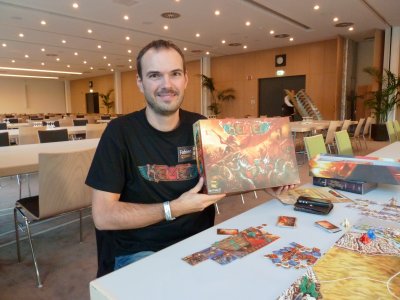
After this final session I decided to call it a day and headed home, but I still owe you the next instalment of…
As part of my convention special this year I would like to take you on a trip back in computer game history to the year 1990, when programmers Fred Ford and Paul Reiche III created a space combat computer game which has succeeded in gaining cult status. This game was ACCOLADE's Star Control II. Indeed, the game offered quite entertaining sequences of space combat between various types of ships, but even more important was the fact that the game had a very complex background story in which the player was given the task to save the galaxy from the evil Ur-Quan Hierarchy. Numerous sentient races had to be convinced to join the player's cause, and for this lots of missions had to be performed. There were long sequences of dialogue, and each race had its own specific style of communication, sometimes sinister and dark and sometimes outright hilarious (mind you, this was BEFORE computer games featured speech!).
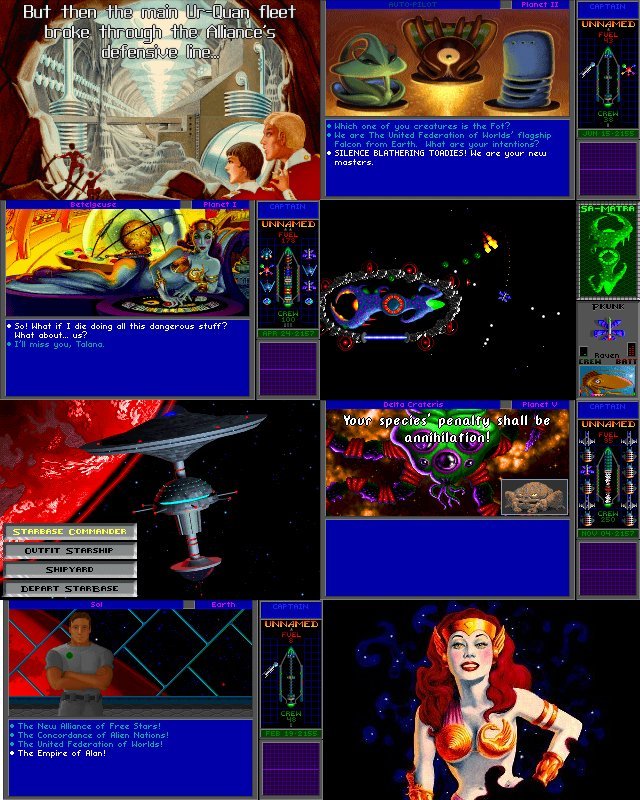
I have never been a computer addict, but this was a game which fascinated me as a youngster, and I played all my way right until the end. Even the final sequences of the game were unforgettable, with the Ur-Quan Space Station blowing up and the player character returning to his homeworld, and a bit later I typed a six-pages walkthrough of the game which was even published in a big computer magazine. I still fondly remember this playing experience, and as a tribute to this great game I have designed the new race for Empires of the Void to resemble one of the races found in Star Control II.
Thanks Paul and Fred for giving me long hours of joy!!!
To keep tension up, I am afraid that I will have to ask you to wait just a little bit longer until the new race is revealed, but you should check back here tomorrow for more infos!
Now I am off to read the latest entries in my guestbook. That's just the motivation I need after all this writing, so your comments are really appreciated! See you soon!
Hello dear Spielers from all around the world!
With saturday being history, we are approaching the final stretch of this year's voyage through the world of boardgames. However, it's still one more day to look forwards to, so there is no need for sadness yet. In fact, while typing these introductory words I feel quite spirited, and this may be partly accredited to the party I attended tonight. Having a beer or two without eating too much all day long might not have been a rather well idea. But we will see - let's just start with today's report!
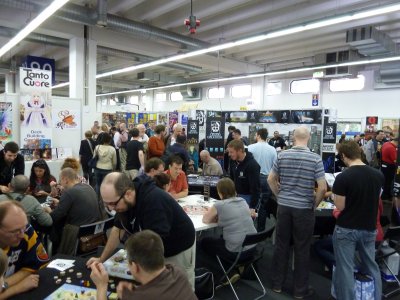
After entering the halls I directly headed for Hall 9, because my first playtesting session for the day was scheduled at the booth of Italian publisher CRANIO CREATIONS. With 1969 the guys from CRANIO have brought a game which attracts me both because of its theme and its nature as being a tactical dice-rolling game, and so I was happy that Lorenzo from CRANIO had reserved me a seat so that I got an opportunity to start the day with this game.
 Once again returning to my days of computer gaming, I have been rather fond of a PC-game called "Buzz Aldrin's Race into Space". The game was playable by up to two players, and the players were put into the director seats of the NASA and the Soviet space agency. Starting from scrap, the players had to manage their budgets to develop technologies and train astronauts in order to compete in several space missions. The player who was first able to successfully complete a mission usually was rewarded with a better income in the following season, but ultimately the players competed to be the first nation to accomplish a successful lunar landing. Being a game with simple VGA graphics, I remember the game quite fondly despite its age, with one of the highlights being the use of real names and the inclusion of real video footage for all missions taken by the players.
Once again returning to my days of computer gaming, I have been rather fond of a PC-game called "Buzz Aldrin's Race into Space". The game was playable by up to two players, and the players were put into the director seats of the NASA and the Soviet space agency. Starting from scrap, the players had to manage their budgets to develop technologies and train astronauts in order to compete in several space missions. The player who was first able to successfully complete a mission usually was rewarded with a better income in the following season, but ultimately the players competed to be the first nation to accomplish a successful lunar landing. Being a game with simple VGA graphics, I remember the game quite fondly despite its age, with one of the highlights being the use of real names and the inclusion of real video footage for all missions taken by the players.

As it seems, the design crew of CRANIO CREATIONS now has taken us back to the beginning of the space programs, since their newest boardgame 1969 now challenges the players to compete in the race to the moon. However, in order to include even more players, the original two competitors now have been supplemented by Germany, France and Canada, and so up to five players now can try their skills as space directors.
While the completion of the lunar landing is most prestigious for the players, it is not the factor on which the game is won. Instead, the players accumulate prestige points on all their space missions, and the player who has accumulated most prestige points after a total of 7 years (rounds) will have won the game. Thus, the participation in space missions forms the central element of the game, and, as the guys from CRANIO CREATIONS seem to have developed a liking for dice games, the resolution of a space mission depends partly on the roll five mission dice.
A player must chose a different mission to try each round of play, and when a mission has been choosen and the mission costs were paid the player rolls the mission dice in order to see how many successes (green), neutral results (blue) and failures (red) he gets in this mission. The number of failures then is substracted from the number of successes in order to reach the final sum of successes, and if the result of this calculation is positive the player may take this number of steps on the corresponding mission track of the gameboard.
However, this result is not yet final, because the player may get a bonus if he has scientists which are researching the technologies needed in this particular mission. On the other hand, the other players may reveal Intelligence cards which may bring a loss of one or more steps for the active player, and he may only counter these losses by revealing some Intelligence cards on his own. After all these modifications have been added and substracted, the player will place one of his flag tokens on the space of the mission track which he was able to reach, and he will score prestige points according to the value printed at this space.
The flag placed on the mission track is used for two purposes. On the one hand it is a reminder for this player that he may not try this mission again for the rest of the game, and on the other hand each flag on the mission track means that a player who tries this mission at a later point must reduce his final yield of prestige points by one for each flag already present on the track. This is a nice reflection of the fact that the players are participating in a space race in which it's most rewarding to be the first to accomplish a mission. However, the fact that a player only may try each mission once means that he must consider carefully whether he is really ready for this particular mission, or whether he should invest a bit more into acquiring scientists and / or Intelligence cards at the risk of one or more other players trying the mission earlier.
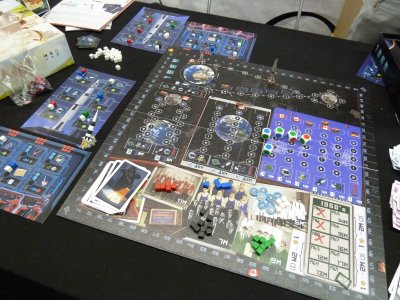
Each round the mission phase is preceded by the investment phase, and in this phase the players may spend money to buy Intelligence cards and hire additional scientists. The players receive a fixed income at the beginning of every round, and money also can be saved from one round for the next, but if a player runs out of money he may also spend previously earned prestige points to increase his budget. The value for spending prestige points this way increases from round to round, but of course these points will be gone when the final scores are added up and the winner is determined after the seventh round.
The Intelligence cards which can be acquired are pretty straightforward, since they are randomly drawn and display just a numeric value between "1" and "3". As indicated, these cards may be used by the players during the mission phase either to increase their own mission result or to decrease another player's result, and for these actions the card values will be used to see how successful the action is.
Much more varied is the acquisition of scientists, since the available five different kinds of scientists may be used to conduct research in 12 different fields of study. Six of these fields of study are technologies like the Launchpad or the Lunar Module, and each scientist present will increase a player's score of successes when he tries a mission in which these technologies come to bear. However, as indicated the player can hire different types of scientists, and apart from the basic scientists the players can go for a more famous scientist who will earn additional prestige points at the end of the game, or an even more expensive genius who counts twice when calculating the number of successes. On the other hand, it is also possible to hire cheap rookies, but being unknown newcomers they will cause the loss of some prestige points when the game is over. Each field of study only may be occupied by a maximum of two scientists, and since scientists cannot be moved or removed the players need to choose carefully which scientists they want to purchase.
Other fields of study deal with other factors of the game, and so the research of Intelligence means that the player gains free Intelligence cards each turn, Robotics reduces the cost to hire additional scientists and Simulation allows the re-rolling of mission dice. The research of Investors on the other hand reduces the cost of missions, and Ground Control allows the change of neutral mission dice results to successes. Once again, the strength of each of these fields of studies depends on the scientists which have been placed there, and due to this correlation the players have a certain degree of control on their fate because they can decide which scientists they want to hire.
Being the ultimate goal, the lunar landing mission takes a special position in the game, and so the players can score a great number of prestige points if they are able to score a high number of successes in this mission. All six different technology-related fields of study come to bear in this mission, and so a player who has placed good scientists in these fields of study can count on getting a fair result of additional successes. In addition, the players may get bonus successes for each other mission they were able to perform at the highest level, and so the lunar mission means an ultimate tests for a player's balancing skills, since now it will be seen whether the player was able to juggle the game's mechanics in a way to get a high yield of prestige points without loosing too many points on the way.
As indicated earlier, the feeling of competing against the other nations is nicely reflected by the fact that a player who comes late in trying a mission will earn less prestige points than his competitors. In addition, the authors of 1969 have tried to add some more direct means of player interaction, and this has been implemented by the use of the Intelligence cards and by the possibility to purchase spies - a special kind of "scientist" which can be placed into other players' fields of study. Once placed, these spies form an obstacle because they count for zero successes and cannot be removed, while at the same time the player who has sent the spy profits from an additional bonus success in his own field of study. However, it remains a matter of taste whether these covert actions really can be seen as a valuable increase of direct player interaction, or whether they actually serve as a balancing mechanism, effectively giving the other players a chance to pick on the leading player. Deep rooted strategists might reject such a mechanism because they will feel betrayed for not receiving the best result for their strategic efforts, but perhaps players with such feelings should better skip tactical dice-games altogether.
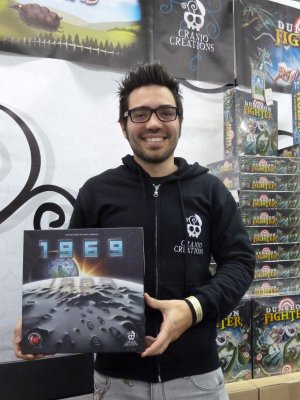
However, 1969 certainly will appeal to players like me who have a soft spot for games like Kingsburg. The game starts with a short phase of decision making in which each player tries to decide on a general approach to the question which fields of study should be researched, and later on the players are confronted with the task of developing appropriate reactions for other players' actions on the mission board. As indicated, 1969 takes an approach similar to Kingsburg, since both games challenge the players to find out whether they can successfully implement some of their early decisions.
Overall, the game has succeeded in positioning itself on a rather strong position due to its entertaining mechanics which reflect the background story of a race for space quite well. Some tension builds up when it comes to the determination of a mission outcome, and due to the use of the Intelligence cards all players remain involved even though it's another player's turn. This degree of tension holds up right until the last round, and so 1969 can be recommended without reservations to all fans of modern semi-strategic dice-games.
By the way: I re-wrote history today! Canada was the first nation to conquer the moon!!!
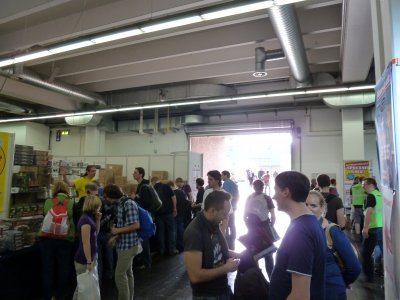
When I left the booth of CRANIO, something unusual had happened in Hall 9. The staff of the convention place finally had given in to the Indian Summer which has hit Essen during these SPIEL days, and they had opened the roller gates. As a result, the air in this part of the show was much better than in some of the other halls! This hasn't happened for years!
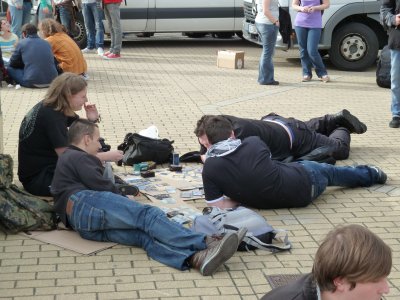
In the inner courtyard, lots of people were enjoying the sun, and it wss even war enough to lay on the plastering in order to play a game or two. That's a way to go!
I next headed to the booth of MATAGOT because I still wanted to try the one demo copy of Room 25 which was available at their booth. Unfortunately the game had not made it to the SPIEL due to the cover being misprinted, and this is all the more annoying for MATAGOT because all playing components are ready to be boxed. Anyhow, I was lucky today to get a seat at the table where the demo copy could be tested, and so let's directly go for this rather unusual playing experience.
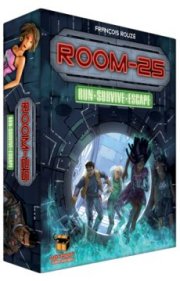 Over the last few years the guys from MATAGOT have made themselves a name with lavishly equipped big boardgames, and games like Giants, Takenoko or this year's Kemet truly stand apart from mainstream products with their beautifully designed components. However, the new game Room 25 now proves that the MATAGOT designers are not restricted to big strategy games, but they also are able to identify and publish smaller games with extraordinary playing mechanisms.
Over the last few years the guys from MATAGOT have made themselves a name with lavishly equipped big boardgames, and games like Giants, Takenoko or this year's Kemet truly stand apart from mainstream products with their beautifully designed components. However, the new game Room 25 now proves that the MATAGOT designers are not restricted to big strategy games, but they also are able to identify and publish smaller games with extraordinary playing mechanisms.
Room 25 presents itself as a mixture between Roborally, Kramer's Labyrinth and the Schwarzenegger-movie Running Man. All player characters are participants in a bloodthirsty TV-show, and they have been forced into a labyrinth of 25 rooms which they must try to escape. All player characters start in the Central Room of the labyrinth, with the remaining 24 room tiles being positioned face down around the central room to form a 5 times 5 rooms playing area. As can be guessed, the face down rooms contain all different sorts of nasty surprises, and to make it worse the players only can escape if they succeed to reach the hidden escape room ("Room 25") together as a group. If the group is not able to escape within a certain number of rounds, the players will have lost the game due to depressurization of the whole complex. What an incentive!
Before the players act with their characters they have to assign their character two orders which will be dealt with in a fashion comparable to Roborally. However, no player may choose the same action twice during the same round, and so they have to choose which two actions they want to perform. The variety of available actions is quite restricted, and so a player may secretly look at one of the neighbouring room tiles, move into an adjacent room (and possibly trigger its mechanism), push another player into an adjacent room or activate room control. If room control is chosen, the player removes one room from either end of the row or column of rooms in which his character is standing, and he adds the room at the other end of the row, thus pushing all other rooms one step sideways. Some special restrictions are applicable concerning the Central Room, and so a room control action never may result in a movement of the Central Room, and furthermore no player may be pushed from the central room into a neighbouring room.
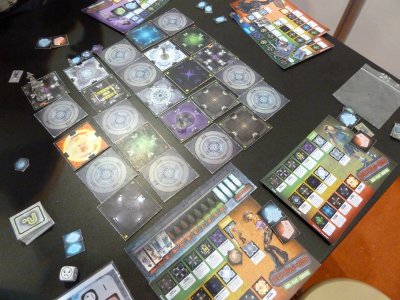
The actions are resolved in player order, with the first player starting with his first action and all others following suit. Then the second action is dealt with in likewise fashion, and when all orders were resolved the countdown for this evil game is reduced by one. Player order rotates clockwise, and a new round begins.
As indicated, the players must flee together, and so all they need to do is reach Room 25 and use a room control action. However, the other rooms of this labyrinth pose a formidable challenge, containing deadly traps (e.g. "Trapped Chamber" - Leave this room with your next action or die; "Mortal Chamber" - When you enter this room you are instantly killed) or other kinds of time-consuming obstacles (e.g. "Prison Cell" - you can only leave this room if a character is in an adjacent room; "Vortex Room" - move your character back to the Central Room). Apart from the Central Room and Room 25, 14 different types of rooms are available, and the composition of the complex depends on the difficulty level the players have chosen for the game.
However, the setting has not yet been fully revealed, because the players also need to choose a game mode for playing Room 25. The producers of the TV-show thought that it's not enough that the poor player characters have to fight against the perils of the labyrinth, but instead some of the different game modes force the players to compete against each other. That's the point where the "Push"-action becomes important, since now the players will try to push other characters into the perilous rooms, just trying to remove their competitors form the game. These competitive game modes vary from groups to single players, bust most nasty is the so-called "Suspicion Mode". In this mode the players must try to escape together, but one or two of the participating characters secretly have been assigned a "Guard" badge. Just like the traitor in Shadows over Camelot, the players do not know the identity of each other, and so the guards are hidden at the beginning of the game. It is their goal to remove two normal player characters in order to win, whereas all other characters need to come together in Room 25 to win the game.
The different game modes are the highlight of Room 25, because the players need to adapt their playing styles to the different situation as prescribed by the chosen mode. Although the volume of rules in Room 25 is rather manageable, the game challenges the players with an interesting planning task because they have to "program" two actions for each round. This need to predict the actions of the other players results in a high degree of speculation and even bluffing, and coupled with different game modes the tension is incredibly high. Players are drawn into the game right from the beginning, and the moderate playing time offers a high incentive for several shows in a row!
With me being lost in this scary maze, let's have a look how Ralf was faring today!
|
Hello again! 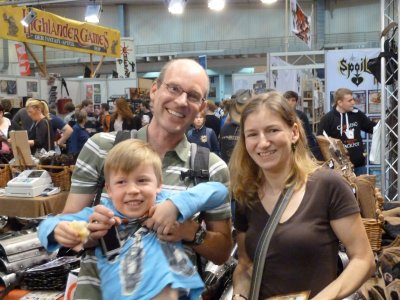 As announced yesterday, today I came to the fair with part of my family. Next to my wife my older sun attended the convention for the second time and he also brought one of his friends along. That's why I can't provide you with many new playtesting sessions today, but instead I will give you a rough overview about what you can do at the SPIEL with your children. In fact, a lot of people are coming with their children and even for the very young there are some interesting booths. But before I began my family day, I asked my wife to take the two boys for about an hour, so I could join Frank at CRANIO CREATIONS where we were introduced to two very interesting new games. Frank had another appointment after1969 ended, so I took over for the second one, a short but funny family game. Playtesting session: Sheepland (Cranio Creations, Booth 12-42 )The world of sheep must have been like paradise, until somebody invented fences for the Shepherds. Something like this could be the introduction of the game. Our task in Sheepland is a quite simple one. We are the bothersome Shepherds and try to corral a big flock of sheep on the best land we can find. For this each player gets a Shepherd and some money at the beginning of the game (In a two-player game you will get a second Shepherd to better balance the game). The board shows us an island with six different terrain types. At the beginning of the game, we place one sheep in each of the 18 regions of the board and one special black sheep in the middle to a town called Sheepsburg. Then we begin to corral our sheep with the help of our Shepherd pawns by putting up fences in the landscape.  But how does this work exactly? In a turn a player can do three actions. The first one is the moving of a sheep from either of the two regions adjacent to our Shepherd to the other one. This is a very important action, because it is the only possibility to corral your sheep flock and herd your flock of sheep together. By moving your Shepherd (2nd action) you automatically place a piece of fence on the space your Shepherd moved from. So with progressing time, the landscape becomes more and more fragmented. Sometimes it is also necessary to move the Shepherd to a place far away from the current position. This is possible, but you have to pay for it. Buying one of the terrain tiles (3rd action) costs money, too. The choice of the terrain tiles is the most important one in the whole game. For each terrain there are five terrain cards. At the beginning of the game they are sorted in ascending order. While the first of the terrain cards are still available for free, you have to pay up to four coins for the last one. Terrain cards are comparable with shares, so by taking one of them you do not own a specific region on the board, but you are only investing in that type of terrain. This leads us to the end of the game and the final scoring. When all fences are in play, you count each type of your terrain tiles and multiply it with the number of all sheep that stand on the respective terrain type. This is your income and together with the money you have saved during the game, it is your total wealth. As you will guess, the wealthiest player wins the game. However, I have not yet explained the rules for the black sheep. This special animal moves at his own leisure. The direction of its movement is determined by a die at the beginning of each turn. In spite of his own will, you should try to catch it, because in the final scoring this sheep counts as two. I really liked the playtesting and I can imagine that Sheepland will be ideal as a filler at one of my next gaming events. It is a very fast game, concerning both the explaining of the rules and the game itself. Still, you can do a lot of tactical moves. I guess that children will also have a lot of fun when they move the lovely sheep and the Shepherd on the colourful map. So I wonder why I had not brought the children along to this meeting, but I will try the game with them in the next weeks. Anyway, after this playtesting session I took over the children from my wife and we set foot on the hall with all the swords and armours you need for live role playing games. Of course this was a highlight for the children. After some time I could tear them away. At the moment my son is an avid fan of Star Wars. I really don't have a clue from where he knows the names of all the important figures, because he neither saw any of the films nor did he read a book or a comic. And I also don't know why the Star Wars theme is so very present again. KOSMOS alone has come with three novelties that are connected with Star Wars. I am quite sure that I have missed this new kind of boom, so perhaps someone can enlighten me... After some encounters with the one or other Star Wars game and gimmick, I managed to lead the two boys to the Lithuanian publisher LOGIS. LOGIS is a specialist for lovely educational games. 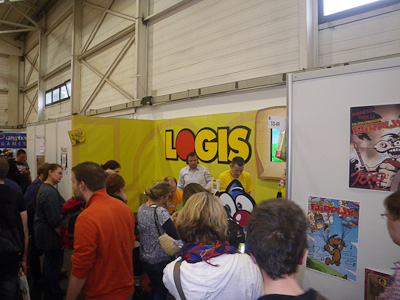 Here we tried Der Zauberberg and some other games in which the children are encouraged to improve their mathematical and linguistic abilities. Some years ago I bought Mit den Bären zählen. With this game my son learnt to solve his first arithmetic problems. In my opinion the games are really well done, the only disadvantage is, that they are only interesting for the children for a very short period in their life. Next stop was a booth with ZomeTool. 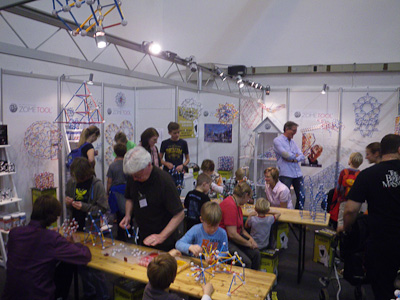 Here the children got lost in constructing fantastic buildings. It was hard to to get them away from this booth, and I made the "mistake" to lead them directly to the next attraction for children (and grown ups). Cuboro is the one and only marble run. If you want to have a rest, you only have to bring your children to the booth of Cuboro, find a chair and sit down. I will assure you, you won't see your children for the next hour. 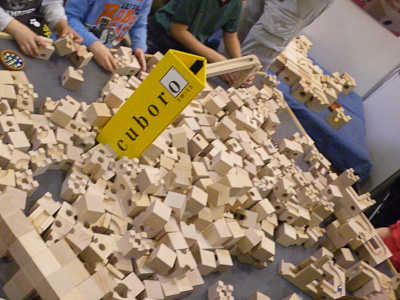 I only was able to continue our tour because I promised to find our way to the hall with the big trampoline. On our way we made a last stop at the booth of ASS where we tried a difficult memory variant. TING is a pen with a sensor that can read codes inserted on the pages of a book or similar material. This code is linked to audio files that are read out by the pen. My son loves this gadget and I must confess that there are some very good books for TING.There even exist some first board games for the pen. In the animal memory variant we tested you do not flip the cards, but you only touch them with the pen. Then the pen reads out the name, makes a typical noise or describes of the animal. The rest goes like in a usual memory: you have to find pairs. A funny idea, but the children could not really concentrate any more. So we moved to the gallery hall where they could blow off some steam. So, I am now preparing my visit for tomorrow. I hope I will be able to find a seat at the one or other table. Sometimes that is not too easy. For example, for the last two days I am trying to playtest the new game Winter Tales from ALBE PAVO, but since there is only one table for this game at the booth of HEIDELBERGER I was not able to come through until now. In my opinion the first impression of the game looks very promising. As far as I could derive from the rules, it's a narrative game with very attractive illustrations and some interesting details. Perhaps I will have more luck tomorrow, so that I will be able to give you some first impressions of the game.  |
Well, I have finally found a way out of the labyrinth of Room 25, and so I can take over once again to tell you about the rest of my day.
For over a year German domestic politics have been unsettled by a series of scandals around some of our leading politicians, but these scandals have nothing to do with sex or corruption. Instead, our politicians do like to show off if they have received a Ph.D. at university, and with the development of anti-plagiarism computer-programs some politicians have been proved that they were guilty of plagiarism on a grand scale. It is possible that they either used a paid but incapable ghostwriter for their thesis, or that they simply wanted to save effort, but in the end this scandal has led to the recession of the Minister of Defence, and the chairs of several other politicians are shaking as well.
Why am I telling you al this? Well, due to these scandals Friedemann Friese finally had found an inspiration for his Friday game project, and so he started with the creation of Fremde Federn, a game which blatantly copies some of the most popular playing mechanisms of the last years. And as if this all was not enough, the game thematically is concerned with the rise of politicians, with the players using all possible means to triumph over their rivals in an upcoming election
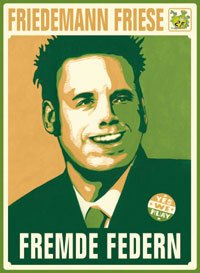 Well, this raises the question which playing mechanisms have been popular over the last few years, and here - among other candidates - games like 7 Wonders, Agricola, Through the Ages and Dominion have been in high esteem by gamers all around the world. And indeed, Fremde Federn first was meant to take essential mechanisms from all four of these games, and only by the end of the design phase Friedemann removed the circular drafting mechanism found in 7 Wonders because it was overburdening his game. But now let's have a look whether these different games really can be welded together to form a playable new game.
Well, this raises the question which playing mechanisms have been popular over the last few years, and here - among other candidates - games like 7 Wonders, Agricola, Through the Ages and Dominion have been in high esteem by gamers all around the world. And indeed, Fremde Federn first was meant to take essential mechanisms from all four of these games, and only by the end of the design phase Friedemann removed the circular drafting mechanism found in 7 Wonders because it was overburdening his game. But now let's have a look whether these different games really can be welded together to form a playable new game.
In Fremde Federn each player begins the game with his own identical deck of cards and his staff of three campaign aids, and - just like in Dominion - it will be the aim of the players to improve their deck during the course of the game, adding strong cards which can provide victory points and removing the weaker cards from the starting deck in order to make the deck more efficient.
New cards from the deck can be obtained from a purchase bar which features a certain number of cards. This purchase bar is taken from Through the Ages, meaning that the cheapest cards available to the players are available at the left end of the bar, whereas surcharges have to be paid for cards from the right end of the bar. If the leftmost cards are not purchased during a round, some of them will be removed, whereas the other cards are shifted leftwards so that new cards can be added by the right end of the bar. These cards come from a semi-random deck which is split into five sections, with the cards of each section being shuffled on their own and with the section decks then placed on top of each other. This ensures that the cards will get more and more powerful and expensive during the game. However, and here is a minor change concerning the rules of Through the Ages, the purchase bar also may contain some useless cards which offer no possibility for action at all, and when making a purchase a player is forced to take all useless cards left of the purchased card into his own deck.
The cards of the player decks and also the cards which can be purchased offer different benefits, with some of the cards giving money or victory points, whereas other cards allow special actions or even may be used to add additional campaign aids for the ongoing round. Each player begins a round of play with five cards from his deck, and during the course of the round the players may use these cards whenever it is fitting (purchase cards showing coins in the purchase phase etc.). However, before any cards are played, the players first must determine the player order for the upcoming round, and for this the players simultaneously have to chose one of their hand cards and discard it into their individual discard piles. As each card in the game has a number (the better cards have the higher numbers), the values of the discards now are used to determine who plays first, so that the players face the choice whether they want to discard a high-ranking card, thus playing first but loosing the card's powers for the current round.
When the player order is standing, the players come into the action phase, and here they may start to place their campaign aids on different action spaces on the gameboard. During the course of the game, one additional new action will be added to the gameboard each turn, and this is the point where we finally have found the element of Agricola which has been incorporated in Fremde Federn. The actions available on the gameboard once again range from the possibility to purchase cards to additional money for purchases, victory points or special actions like the destruction of cards from the players decks. Each action on the gameboard only may be chosen by one player, and so it is important to be first player in order to choose freely among the available actions. However, not all actions are instantly performed, but some actions (like the purchase of cards) are used in the purchase phase which follows when all campaign aids have been placed and other actions were performed. For this reason the campaign aids are standing on spaces which still can be used, whereas they are turned to lie down when the space's action has been used.

As indicated, the players need to tune their individual decks to high efficiency, combining cards which score victory points (during the course of the game, not at its end) with other useful action cards which may give even more possibilities in the action phase. The game ends when one of three conditions is met: when one player has reached 95 victory points, when the 11th round has been played, or when the deck of cards available for purchase is depleted. The last four cards in the deck actually are Ph.D. degrees which can be purchased, and they allow the transfer of money from cards in the player's decks into victory points.
Can we really play a game which takes core mechanisms of other games, puts them into a blender and then claims to be playable? Yes we can! (Sorry, but I couldn't resist.) In fact, the game plays extraordinary well, with the different mechanisms supplementing each other without overburdening the game with an extreme volume of rules. In fact, the rulebook is barely six pages long, describing all parts of the game with the needed degree of detail and giving some hints from the author. However, Friedemann's great experience as a game designer becomes visible when you compare each mechanism in its original form with the way it has been implemented in Fremde Federn. Friedemann could not just take these mechanisms and put them together, but instead he needed to make some small but decisive changes at certain points in order to make the mechanisms work together smoothly. For me, the combination of these three mechanisms is a stroke of genius, even though Friedemann has worked with other authors` ideas. Even the title of the game Fremde Federn nonchalantly plays with a German saying which accuses someone of stealing someone else's ideas, but it is good to know that Friedemann did ask each of the involved authors for their permission whether he may use their mechanisms for his game. As a result, Friedemann now presents the gaming world with a game which features not one but several of the most popular playing mechanisms, and he invites the players to try his rather unusual creation!
After this strange playing experience I once again returned to Hall 4 where I was hoping that I would finally get a chance to play Tzolk'ien: The Mayan Calendar. I had listened to a round of rules explanation around noon, but since I had another meeting on schedule I just watched some other players play. Now I was lucky, since shortly after my arrival at the CGE booth a new round was started!
 In fact, this game was puzzling me right after seeing first images, since a gameboard with huge turning gears simply made me wonder what the editorial staff from CGE might be up to this time. Being created by Simone Luciani and Daniele Tascini, two relatively unknown Italian authors who have also created Sheepland, this new game with a South American background promised to be a real brain-teaser due to the ever changing situation caused by the interconnected gears.
In fact, this game was puzzling me right after seeing first images, since a gameboard with huge turning gears simply made me wonder what the editorial staff from CGE might be up to this time. Being created by Simone Luciani and Daniele Tascini, two relatively unknown Italian authors who have also created Sheepland, this new game with a South American background promised to be a real brain-teaser due to the ever changing situation caused by the interconnected gears.
Indeed, Tzolk'in: The Mayan Calendar proved to be a fully grown-resource management game which was interwoven with an unusual mechanism of worker placement. The players take the roles of tribes during the high time of the Mayan culture, and each player tries to gain victory points by collecting resources, by erecting monuments, by engaging in specific victory point actions and by raising in the favour of the gods. As can be expected from a good resource management game, Tzolk'in: The Mayan Calendar offers well developed possibilities to turn resources into victory points, not forcing the players to follow one specific way but instead allowing them to test their own ideas and strategies.
However, and here the game is not just optically different - the traditional approach to the gathering and consumption of resources is changed quite dramatically by the huge gears on the gameboard, and so let's leave the somewhat well known parts of the resources, workers, buildings and victory points in order to give the big gears a closer scrutiny. There are five smaller gears available, and all of these gears are interconnected with the big "Tzolk'in"-gear in the middle of the gameboard. At the end of each round of play, this big gear will be rotated one step in a counter-clockwise direction, thus resulting in a one-step clockwise move of the five smaller gears. Due to this interrelation, the big gear effectively serves as a timekeeper in the game, since the game will end when the big gear has finished one full rotation. Spread evenly around the big gear special events are marked, and so the game actually is evenly divided into two ages, with each of the ages being subdivided into two "food"-days in the middle and at the end of each age. During all four food days the players will need to feed each of their workers with two units of corn, and they will loose victory points for each worker who cannot be fed.
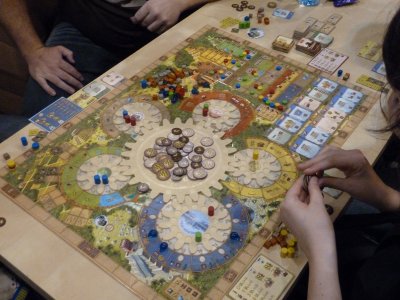
However, these four days are even more important, since on all four food days the current positions of each players' markers in the three temples of the gods are evaluated. Each of the Mayan gods Quetzalcoatl, Chaac and Kukulcan (an ancestor of Kulkmann?) has his own temple on the gameboard, and during the course of the game the players may rise and fall in the esteem of each god, depending on the actions they perform. During food days 1 and 3 the players will receive material benefits like resources depending on their current position within each of the three temples, whereas food days 2 and 4 are accompanied with a scoring of victory points, with the highest ranking player in each temple receiving most points. Finally, the transition from the first age to the second age happens when the Tzolk'in gear has finished half a rotation, and this means that the display of avialble buildings will be changed so that now the buildings of the second age become available.
But let's return to the function of the smaller gears. During a round of play, each player is allowed to take a turn, and during his turn he must either place one or more of his available workers at the lowest free space(s) of the smaller gears, or - if he cannot or doesn't want to make such a placement - he must take back at least one worker from one of the gears. Next to each gear on the gameboard spaces with benefits can be found (resources or possible actions), and a benefit can be taken or an action can be performed only if a player possesses a worker who is positioned on a gear which is aligned in a way that the worker is standing directly adjacent to the gameboard space in question. Only if this constellation is met, the player can take his worker back, thus enabling him to take the benefit or perform the action. As indicated, a player even is allowed to take back more than one worker during the same turn, thus allowing him to take several benefits and perform actions in an order which he deems most favourable for his own designs.
Each of the five smaller gears on the gameboard represents one of the important Mayan centers of civilization like Tikal or Chichen Itza, and due to the diverse activities associated with each of these cities the actions available at each of the five gears differ quite considerably. So, one of the cities is the main source for corn, which is needed both for feeding a player's workers and as the general currency of the game. Another city focuses on other resources like stone, gold and Crystal Skulls, and these objects once again can be used in other cities where they can be invested into building activities or research. By research the players can gain benefits which will make their actions on specific gears more profitable. Of immense importance also is the gear representing Chichen Itza, since this is the place where the players can get rid of the rare Crystal Skulls, and the spending of a Crystal Skull usually will allow a player to raise in the favour of the gods. As a general rule concerning all gears, the benefits which a player can get are getting higher and higher with every step a worker is pushed forwards, so that it really pays off to leave a worker on a gear for several rounds.
Certain rules apply to the placement of workers on the gears, and so a worker must be placed on the first free space of a gear. This may mean that the worker may begin on an advanced space, but such a placement only can be made if the worker's owner is able to pay an additional amount of corn for making this placement. This is meant to counterbalance the fact that otherwise the player would receive a big advantage by placing a worker higher than the usual starting space. In addition, the players retain some flexibility how to use their workers, and so a worker actually may be used to perform any of the activities on the spaces which he has already passed. Once again, this comes at a price, and this time the player must spend one corn for each step the worker goes backwards. Finally, the situation may arise that a worker is moved too far, leaving the available spaces of his city. This location usually should be avoided because the last space in each city allows a freely-chosen action from that city to be performed without any additional cost, but if the player cannot avoid his worker being pushed out of the city the worker will go back to the personal stockpile of the player.
A mechanism of delayed availability is not new in the world of boardgames, and so games like The Circle or Macao have successfully challenged the players to plan their actions ahead by the use of a circular device. However, in Tzolk'in: The Mayan Calendar the whole matter is taken onto a whole new scale, because here the players have not one but actually five gears which they need to worry about. During the first few rounds it's still fairly easy to keep an overview on the positions and uses of each player's three starting workers, but during the course of the game the players may expand their workforce to up to six workers, and that's when things get somewhat more difficult to manage.
Still, judging from this first playtesting session, the game seems to be rather well balanced, and furthermore the abilities and benefits available at each of the five city gears are not too far fetched to make the players loose track of their possibilities. Quite interestingly, quite the opposite seems to be true, because the players just need to take the initial hurdle of getting to terms with the movement of the gears and its meaning for a player's workers. Once this first step is mastered, many of the activities found in the game are quite close to other build-and-develop games, and so especially seasoned players quickly will be able to find their way through this seemingly new territory.
I cannot remember a boardgame where interconnected gears were given such a decisive role, used as a "motor" to enhance the playing mechanism of the game. Here a big awards for originality should be given to Simone Luciani and Daniele Tascini, since they succeeded in creating a game which has the potential to fascinate players for many hours to come.
In fact, after this last session my capacity to absorb any more rules was exhausted, and so it was lucky that Danielle from REPOS PRODUCTION had invited me to a party at their booth. Quite a few people from Belgian and French companies were attending, but I also met Friedemann Friese whom I asked about the story behind Fremde Federn.
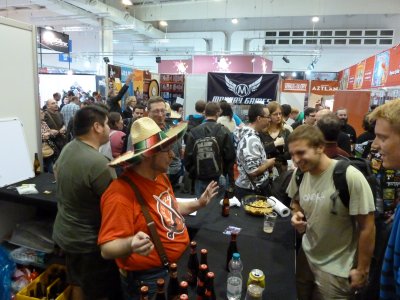
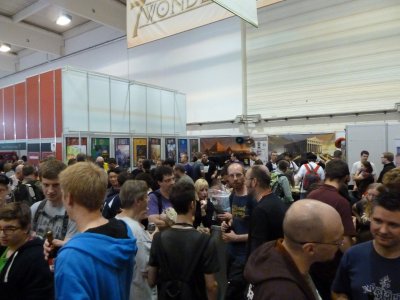
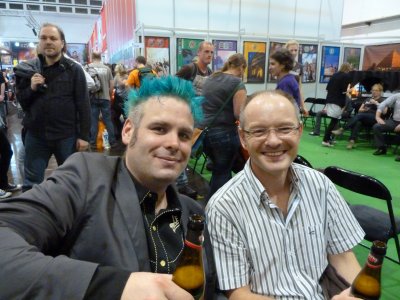
I asked Friedemann whether he first had the idea for the mechanisms in his new game, or whether he his first step was to the decision to create a game which deliberately uses not one but several well-known playing mechanisms. Friedemann told me that he really started with the idea of combining some popular mechanisms, since he is a bit fed up with the modern development that popular mechanisms quickly are reproduced in some follow up products which claim originality on the base of a few minor changes. Thus, he was thinking about creating a game which ironically exaggerates this development, and when the Ph.D.-affair begun in German politics he finally thought that the time had come to start the creation of Fremde Federn. With this background I am even more amazed how much care Friedemann has put into his project to hone the rules to good playabilty, and for me this game really was one of the highlights of the SPIEL!

However, as the Belgian beer was starting to take its toll on me (Cedrick already seemed a step ahead…), I left the party after an hour in order to start typing. On my way out of the convention area I stopped at the neighbouring Atlantic Hotel. Eric Martin from Boardgamegeek was already waiting for me, and together we carried two big boxes of games to my home. I am going to mail them to Eric in the next couple of days, because taking them as excess luggage on a plane simply would be too expensive.
Still, something is still missing in order to complete this day, and so let's have a look at the next part of…
Of course, something is still missing, and what could be a better ending for a convention day than the presentation of the next instalment of this year's convention giveaway. So far you have only seen planet Belshar, but today you will get a hint at the nature of its inhabitants…
On board of the "Behemoth", flagship of the Grand Admiral:
"Sir, we have entered the star system of Belshar, and in a few minutes we will have visual contact of Belshar II. This must be the homeworld of the Sirens!"
"Thank you, Ensign." replied the Grand Admiral. "Keep me informed on our progress, and lauch our of wing of Starfighters immediately upon arrival at the planet's orbit."
The Grand Admiral smiled at the prospect of conquering the mysterious planet. The true nature of the Sirens was unknown, as they were trading with the other galactic races through emissaries. However, the exotic goods coming from Belshar were known for their enormous value, and so the Grand Admiral had been sent to subdue this remote world. Other expeditions had vanished on this mission, but he was sure that the Behemoth's wing of high-tech Startfighters would be more than enough to invade a world of artisans and traders.
At this moment the green globe of Belshar slided into view, and only seconds later the squadron of Starfighters was moving towards the atmosphere.
"Sir, we have video contact with someone broadcasting from the planet's surface. In fact, all of our pilots are receiving this signal as well."
The transmission started, and a stunningly beautiful woman appeared on the screen and addressed the invaders. "Starfighter pilots! We know that you have come to conquer our planet, but those of you who abandon this sinister plan and defend our planet will be welcomed as heroes by my sisters and me. You will get shore leave on Belshar as long as you desire, and be assured that this experience will be … unforgettable!"
The last words hung in space for a few seconds, but then the Grand Admiral's eyes widened in shock as he saw the whole squardron of Starfighters blow each other to smithereens. And finally, when the Starfighters had vanished, a fleet of spaceships rose from Belshar to deal with the Behemoth…
You are still puzzled? Well, it will all become clear with the last part of the convention giveaway which will be released tomorrow!
So, see you tomorrow for the grand final!
Welcome back for the grand final of this year's SPIEL-report!!!
I don't believe that it has already happened, but the SPIEL '12 today already is history. I started my reports last sunday, and it's incredible that a week has passed since I took you on a virtual trip through the Gruga-Park.
However, there its still no reason to be sad, because you have a nice long report to read. As traditional on convention-sunday, today was Ladies Day, and so Nicole and I went into the show together.

Having Nicole come along always is an interesting experience for me, because Nicole always is able to find the one or other game which has totally skipped my attention so far. While our gaming interests are quite similar, she simply sees the whole show from a different perspective, and so I was curious to see which games we would find today.
In fact, we have spent the whole day in the show, first playing games and later on saying goodbye to our various friends, whishing them a save journey home. Afterwards we returned home and Nicole prepared one of her fabulous chicken-apple-chutney dishes, and now I am strengthened for another night of wild typing. So, the result of our playtesting will be included in today's report, giving you an extremely interesting choice of a broad spectrum of games!
Nicole actually had chosen one game to test already before the show had started, and this game was Tokaido from Antoine Bauza. The game offers some very attractive artwork, and due to Nicole's strong interest in Asia she wanted to give this game a closer look.
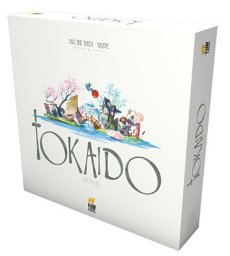 Over the last years author Antoine Bauza was able to surprise the gaming world with some rather elegant designs, and at least from a graphical point his newest creation Tokaido once again comes with rather stylish, elegant artwork which invites the players to learn more about the game. This time Antoine draws the players back to the time of feudal Japan, and the players are sent on a recreational voyage along the Tokaido, the traditional East Sea Road which connected Kyoto to Edo (modern Tokyo). On their way the players will visit Inns and Temples, collect souvenirs and meet different travellers, and on all these occasions the will collect Journey points, Tokaido's equivalent for victory points.
Over the last years author Antoine Bauza was able to surprise the gaming world with some rather elegant designs, and at least from a graphical point his newest creation Tokaido once again comes with rather stylish, elegant artwork which invites the players to learn more about the game. This time Antoine draws the players back to the time of feudal Japan, and the players are sent on a recreational voyage along the Tokaido, the traditional East Sea Road which connected Kyoto to Edo (modern Tokyo). On their way the players will visit Inns and Temples, collect souvenirs and meet different travellers, and on all these occasions the will collect Journey points, Tokaido's equivalent for victory points.
The journey from Kyoto to Edo is split into four sections, and each of these sections ends with in Inn in which all player characters come together before the journey is continued. Along the roads between the Inns, eight different kinds of locations can be found, and at each of these locations one or two player characters may stop. Movement itself is fairly straightforward, since it is always the player who is furthest back on the road who may next move his character. The character may be moved as far as the next inn, but in order to win the players will try to visit as many locations on the way as possible, since all locations offer beneficial effects and possibly a chance to score Journey points. However, a stop can only be made provided there still is a free space at the desired location, and so the movement strategies chosen by the other players may prevent a player from visiting a specific location, forcing him to go further than he originally intended.
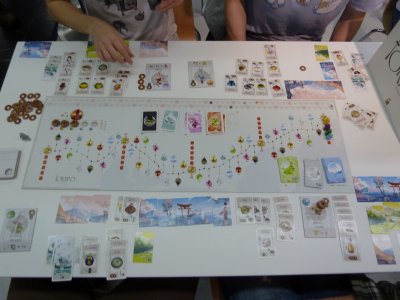
As might be guessed, the choice of which locations should be visited at which time is the key to winning Tokaido, and so the players should familiarize themselves with the specific ability of every location.
A somewhat more specific role is taken by the Inns, since they offer enough spaces for all players to arrive, and so the journey will be continued only after all players have arrived. The players will leave on a last-in-first-out basis, and so a late arrival will guarantee first choice of a location on the upcoming stage of the journey. However, and early arrival at an Inn is not bad either, because the first player to arrive will draw a number of Meal cards corresponding to the number of players plus one, and he may purchase one of the cards he has drawn. Players arriving later may only purchase one of the cards left over by players who have arrived earlier, and so a late arrival means a quite reduced choice of Meal cards. Each Meal card will count for six Journey point, but since each culinary specialty may only be purchased once a player who arrives late will stand a high chance that he will not be able to purchase a Meal card anymore. And once again bonus victory points will be awarded at the end of the game, but this time for the player who has purchased the most expensive meal cards along his journey.
Scoring here, scoring there, scoring everywhere! Whereas some games treat victory points like a precious commodity, Tokaido takes a different stance so that Journey points can be found in high amounts all along the way. So, it is the main task of the players to move their characters in a way which allows them to score as high as possible, while at the same time denying other players access to a location where they would like to go. As all cards collected by the players remain face-up, it becomes an ever-growing task for the players to keep an eye on the collections of their competitors, since only a good overview of the scoring possibilities of all players ensures a chance to win!
Some additional variety is added by the fact that the players draw random characters at the beginning of the game, and so each player starts the game with a varying starting purse and a small special ability which is available only to his character. So, Satsuki the Orphan will receive a free Meal card at every Inn, Sasayakko the Geisha gets a free souvenir whenever she purchases at least two souvenirs, or Hirotada the Priest gets a free donation coin whenever he visits a Temple. Going for an ability-related location is not mandatory if more lucrative options are at hand, but usually the players should try to use these special abilities to gain some "windfall" Journey points along the way.
As can be seen, Tokaido focuses on a fairly straightforward movement and scoring mechanism, but this does not mean that the game is all too easy. As indicated earlier, the players keep looking at the card collections accumulated by all other players, and especially in the final phase of the game some calculations will be made which moves should be most rewarding. As a side effect, the game is slowing down a bit when drawing towards the end, but due to the overall good playing duration this effect is not too pronounced. However, keeping a keen eye on all factors is a key attribute which should be followed by all players, and so a higher degree of focus and concentration is needed than would be expected by a first look at this game.
After this entertaining start we wanted to go and check whether we could join a game of Legends of Andor, but we actually did not get further than a few meters. Close to the booth of FUNFORGE the booth of French publisher JACTALEA could be found, and here yet another small game with an Asian theme catched Nicole's attention. So, we sat down for a quick round of their new game Okiya
 The background story of the game by Bruno Cathala is told rather quick. Two groups of Geisha's want to seduce the Emperor, and they have come to the royal gardens to get his attention. Well, I am not quite sure how this fits thematically, but the first player to get four of his Geisha-tiles either into a horizontal, vertical or diagonal line or into a two times two sqare formation will have won the game. But hos does this work?
The background story of the game by Bruno Cathala is told rather quick. Two groups of Geisha's want to seduce the Emperor, and they have come to the royal gardens to get his attention. Well, I am not quite sure how this fits thematically, but the first player to get four of his Geisha-tiles either into a horizontal, vertical or diagonal line or into a two times two sqare formation will have won the game. But hos does this work?
Each player places the pile of his Geisha-tokens in front of himself, and between the a square of four times four garden tiles is prepared. Each of these Garden tiles contains to different natural features, like flowers combined with a bird or a flowered branch combined with the sun. The game is rather straightforward, with the players alternating to take a Garden tile and to replace it with one of their Geisha-tokens. However, only the first player has a free choice which Garden tile he wants to take, because afterwards the type of new tile which may be chosen by the other player is predetermined by the tile just removed by the active player. Thus, a player always has to chose a tile for removal which shows at least one of the two natural features of the just removed tile, and so the active player has some influence which tile his opponent will take. In order to balance the starting player advantage, during the first round the first player only may take one of the 12 outer tiles, but after the first Geisha has been placed a quite challenging duel of placement develops.
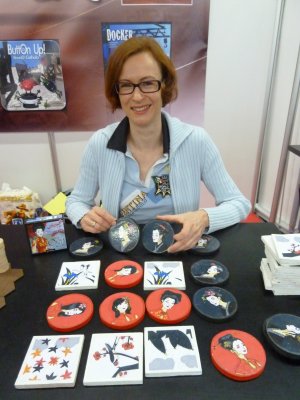
Nicole and I played this game with a much bigger demo copy, and we were drawn into its easy but intriguing mechanism right from the beginning. The game requires the players to be fully present for its full duration, since otherwise the inattentive player quickly will have lost. In fact, it's even possible to win without getting the Geishas into a winning formation, and this happens if the opposing player has been cornered so that he has to choose a Garden tile for which no follow-up is available anymore.
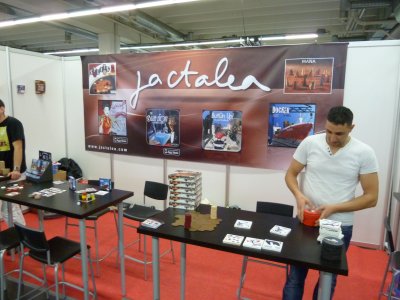
Overall, this was a great find, and although we would have liked to purchase a copy to take it home we were nonetheless happy for the people from JACTALEA that they were able to sell all copies of the game which they had brought to the SPIEL.
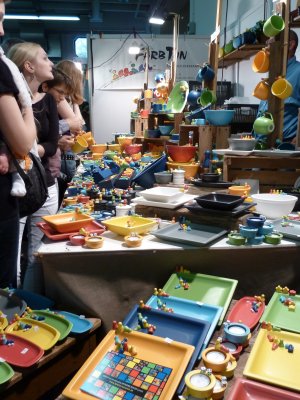
Another cute find which we made in Hall 9 was at the booth of FARBTON KERAMIK, a pottery workshop which has specialised in doing gamer's choice pottery producs. So, you could get colourful cups, bowls, dishes, and as a special attribute some differently coloured meeples and pawns had been added to the design. A quite nice table-decoration for a gaming evening!
We continued to the KOSMOS booth, but unfortunately we were not able to find seats at a table to play Legends of Andor was played. However, I had already familiarized myself with the rules, and I remembered that the press-rooms where the new games are presented usually are rather empty on a sunday. Thus, we went to the novelty show and tested the game up there.
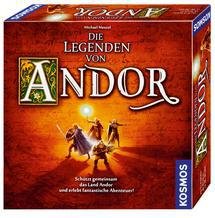 Entering dungeons and slaying vicious monsters has been a favourite pastime for generations of gamers, and classic games like Heroquest, Talisman or Warhammer Quest are still fondly remembered by gamers like me who have got their adolescence well behind them. You could spend hours moving miniatures and rolling dice in combat, with your goal just being the ultimate survivor or - if played as a group - cleaning the dungeon / wood / castle of all evil monsters. However, despite the seemingly endless joy generated by these games at their high time, there was always one factor which was less pronounced than in other boardgames. This factor was strategy, since in most cases the players strongly depended on having a lucky hand in rolling the dice and much less in any active decisions they could make.
Entering dungeons and slaying vicious monsters has been a favourite pastime for generations of gamers, and classic games like Heroquest, Talisman or Warhammer Quest are still fondly remembered by gamers like me who have got their adolescence well behind them. You could spend hours moving miniatures and rolling dice in combat, with your goal just being the ultimate survivor or - if played as a group - cleaning the dungeon / wood / castle of all evil monsters. However, despite the seemingly endless joy generated by these games at their high time, there was always one factor which was less pronounced than in other boardgames. This factor was strategy, since in most cases the players strongly depended on having a lucky hand in rolling the dice and much less in any active decisions they could make.
With the release of Legends of Andor it becomes clear that author and illustrator Michael Menzel shares a general fondness of fantasy boardgames, but as it seems he must have embarked on the creation of this game with the aim to create a game where players' decisions really count for something. There were always some unsuccessful tries to reach this aim in the aforementioned games by including missions or quests, but in the end such new elements never could satisfy players who were looking for something with a bit more playing depth. Keeping this thought in mind, Michael Menzel went on to give the classic fantasy boardgame a full overhaul, placing a tactically orientated mechanism at the core of his new game and enriching this new mechanism with heroes and elements of combat known in similar form from other games.
Of course, the kingdom of Andor as displayed on the gameboard is full of interesting places, and during the course of the game monsters will appear on the board and wait for restless heroes with a lust for slaying. However, "waiting" is not the right term in this context, since the monsters actually move on the gameboard. During a round of play (a "day"), each player can spend a total of 7 hours for actions with his hero, and when all players have done their actions the round comes to its end. At the dawn of the new day all monsters on the gameboard will be moved, and this movement follows a specific pattern as prescribed by region numbers and little arrows on the gameboard. Ultimately all monsters will move towards the Royal Castle, and when a certain amount of monsters has reached the castle the kingdom will fall and the players will have lost the game.

So, the players need to slay some monsters after all in order to prevent the sacking of the castle, but why not just slay all monsters and call it a day? Here the figure of the Storyteller comes into the game, and he is represented by a pawn which is moved on a story track displayed on the gameboard. Whenever a new day breaks, and whenever a monster is slain, the Storyteller moves one step forwards on the story track, and when the Storyteller reaches the last space of the track the game will come to its end. At that time the players must have performed some specific deeds as prescribed by their currently played adventure (defeat a certain boss-monster, bring something to the Royal Castle etc.), and if these goals have not been reached the players will have lost as well. So, as can be seen, Legends of Andor puts the players to a general challenge of balancing their actions against the passing of time. If they take too long for performing the tasks of their current adventure, or if they slay too many monsters, the game will be over.
However, the story track does not just serve as a method for keeping the passing of time. As indicated, the players embark upon a specific adventure, and this adventure is outlined on a number of Legend cards which will be placed at hand during setup of the game. One or two of these Legend cards usually will be read to set out the scenario when the game begins, but the later cards will be triggered either by a movement of the storyteller or by specific situations. Thus, these cards only will be revealed when the triggering circumstances have arrived, and at that point the freshly revealed card usually will bring new factors into the game. Thus, the revealing of a new Legend card may bring new monsters or even a new subplot which also must be completed by the players in order to win the game.
The game includes a total of five different Legends, and this might bring up the question whether the replay value drops after all Legends have been solved. However, Michael Menzel also found a possibility to get around this obstacle, and so he included some factors which should guarantee a high playing value even if all Legends have been solved. One of these factors is a deck of event cards which may change some situations in the game, but even more important is the fact that Legends "3" and "5" effectively serve as semi-randomized "playing modes" with some factors changing from one game to the next (monsters appearing at different places, different kinds of playing aids not being available to the players etc.). So, while the other Legends give the players a possibility to learn the game on a step-by-step base, these two Legends form the "full" and "advanced" game which can be played repeatedly. However, it must be conceded that new Legends certainly pose an even higher incentive to play again, and so it should be hoped that additional Legends may be released if the basic game is appreciated by the audience of gamers.
As indicated earlier, the game is positioned on more traditional grounds concerning the players' heroes and combat against the monsters. Combat is solved by rolling dice, with the number of dice depending on the Willpower of the involved heroes and the attacked monster. In addition, both the heroes and the monsters add their Strength values to the highest results of their dicerolls, and then both results will be compared against each other. The lesser result will be substracted from the higher result, and the difference will be the number of Willpower points the monster or the heroes loose. Less willpower may result in less dice for the following round of combat, and a monster is defeated when its Willpower drops to zero. The players' heroes cannot die, but a hero who has lost all Willpower looses one Strength and regains just a meagre amount of three Willpower in exchange for this.
Returning to the crucial element of time, the player actions of movement and combat are focused on the consumption of time. It costs one hour to move a hero from one region to the next, but the hero then can deal freely with any events or items found in the new region. However, it costs once again one hour for each participating hero to conduct one combat round against a monster. As time is limited, the players have to think really carefully how to use an upcoming day with high efficiency, since the game is constructed in a way to pose a formidable challenge to the players. This means that only a few hours may be lost for uneffective actions, since otherwise the Storyteller-"clock" would tick down too fast. The players must act as a group in the best interest of the group, and this means that they should discuss their plans at least once at daybreak. Younger players with an urge to go and kill the monsters may find this discussion a bit unnerving, but it's nonetheless the key to have a chance of winning.
Michael Menzel really succeeded in his primary goal - players' decisions are important in Legends of Andor, and good decision-making decides about winning or loosing. However, despite the fact that the players only spend time for movement and combat, the decision-making process is much more diversified because a number of factors has to be taken into account:
These are just examples of the options available to the players, and in most cases the players' decision on each of these options really counts for something. In traditional adventure games such things happened rather incidentally, with the players following a general "the stronger - the better" doctrine, but in Legends of Andor there will always be the question whether the usefulness of a specific action really justifies the time it costs. However, the list of available options is not long enough for the players to lose themselves in endless discussions, and so the whole process of decision making is still resolved in an enjoyable fashion. And, in the end, there is still an element of luck included, since the players have to roll the dice in combat. While their chances of success can be increased through equipment or ganging up on bigger monsters, there is still a slight chance of failure if everything goes wrong.
So far Michael Menzel was best known as a highly skilled illustrator who has worked on quite a few different games in recent years, but with the release of Legends of Andor the situation has changed dramatically. He has given the whole genre of fantasy games an urgently needed overhauling, introducing some strategic elements to a purely dice-dominated domain. However, the artist in Michael Menzel also was able to enjoy himself in the design of Legends of Andor, and so the artwork on all components is nothing short of "perfect"! A loving eye was given to every little detail, including double-sided male/female character boards, figures with different front- and backsides, extra artwork on some Legend cards etc.. And as if all this would not be enough, even the gameboard is double sided, showing the Kingdom of Andor on front and the Dwarven Mines on the backside. A rather different playing style is required there, since the players have to follow the caverns and track down a sorcerer. What else could a dedicated fantasy player whish for?

As a matter of fact, Nicole and I had chosen the best possible place to test this game, since it requires the players to read the Legends cards aloud and this would have been quite difficult within the convention halls. However, these cards did not just feature mission details, but as I have indicated earlier the cards in the first two Legends actually allow the players to learn the rules of the game during the game. This approach has been tried in different games before, but I have never seen it work so well, taking the players through all steps without ever making the process dry or scholary. Apart from the fact that the game is outstanding on its own basis, the presentation of the rules makes Legends of Andor a nearly unbeatable contestant for the Essener Feder awards for the best set of rules in 2013.
Well, there is still a lot to tell since we have just reached the early afternoon. However, Nicole and I needed a break outside in the sunshine, so why not follow Ralf's footsteps until we have returned!!!
|
Welcome back for my report on sunday, the final day of the convention. Although I have been looking forward to the fair for nearly a year, I am glad now that it will soon be over. As you can imagine, four days of walking through the halls, playtesting so many games and writing in the evenings is really exhausting. But one more report still must be survived. So I am back again to provide you with some more news about the games I tried today. Today I was happy to be joined by Lutz, a close friend of mine. Marco, our third Gamebox co-author also was attending today, but he brought along his son, so I did not see him much. Together with Lutz I began the day with a frantic gaming session at the QUEEN GAMES booth. Playtesting session: Escape (Queen Games, Booth 10-16)10 minutes, not a minute longer, is the time you have to escape a temple before it collapses (do you remember the first minutes of Indiana Jones - Raiders of the lost Ark?). That would not be difficult, but before you are able to do so, you must find gems that are widely spread in the temple. And if I say 10 minutes, then I also mean it. Escape is a real time game, which means that 10 minutes in the game are exactly 10 minutes in reality. So you will understand why I say the game is frantic. At the beginning of the game, we are equipped with five dice which we must use to walk around in the temple and to find the gems. The game is escorted by a soundtrack on CD which tells us when it is time to find the exit. 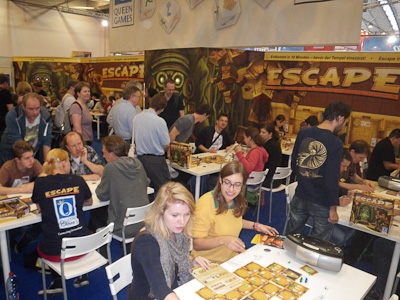 During the game you should roll your dice as often as you can. To find the gems and to walk around we need given symbols on our dice. It is allowed to put aside any dice to collect the right symbols. But beware! Whenever you roll a black mask you are no longer allowed to use the die, until you have rolled a golden mask. Of course it is also possible, that you are blocked, because all your dice show you the black mask. Then somebody else must help you with his dice. So he must move to the room you stand in and must help you with golden masks rolled with his dice. As you can see, you better work in teams, because you are able to help each other with the dice. Two times in the game a gong sounds from the soundtrack. After the first gong, all players must move back to the main chamber of the temple. If someone is not able to reach it in time, he looses one of his dice, which is a great loss, especially in the end game. After the second gong, you must run to the exit. Hopefully you have found enough gems, because otherwise you won't be able for us to leave the temple in time. 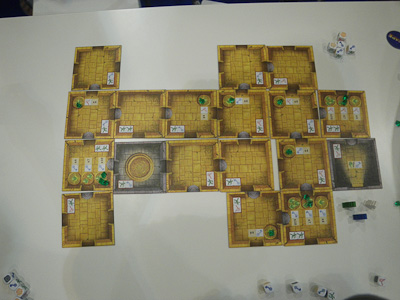 Escape is a cooperative game, so it can only be won if all players are able to leave the temple before the soundtrack comes to an end. The game concept is somewhat new, maybe a little bit comparable with Space Alert. I am not sure about how long the game is able to fascinate the people, but after your first game you want to try it once more, and after the second time once again. I think the success is that the game is very short, difficult enough that you will normally loose your first games and stressful, so that you forget everything that is around you. Already some expansions are available, so you can add traps and other nasty things to adapt the game to your growing experience. We will see if the game is able to stay on the top in the next year... After we were successful in our third game, we left the booth and did not have to drink a coffee like we had planned before. Our adrenalin was high enough, so we could immediately start another playtesting session. Playtesting session: Helvetia Cup (Helvetia Games, Booth 7-104)As promised after my first day, I came back to the Swiss publisher to play a round of soccer. In Helvetia Cup two fantasy teams compete against each other. The one is represented by small dragons, the other by a herd of freaks. Both players get four players and a goalkeeper. All players have individual values for their abilities to play a pass, dribble, do a tackling, shoot and other important things for soccer. First thing to do in a round is the moving of your players. The attacker always begins. One step of each player is for free, if you want run longer, you must spend of your player's boost ability. But you should be careful, because if this is reduced to zero, all other abilities are reduced to the half of their normal values. If, after the movement phase the Defender has a player on the same hex-field as an opponent with the ball, he may try to steal the ball or to tackle the other player. To see if this is a success, you must roll against your abilities with a D20. Against some attacks the other player can play a counteraction, but again he has to check if this was a success with the help of a die. If after this defensive phase the attacking player is still in ball possession, he may try to shoot or to pass the ball to another player. 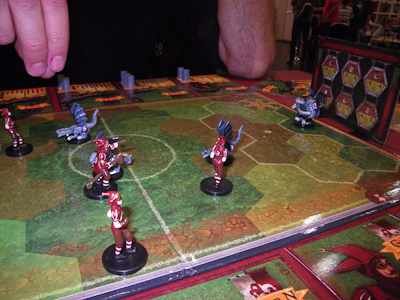 The difficulty of the shot depends on the position of the player, the player's offensive ability and the distance to the goal. First we have to check if the goalkeeper is able to seize the ball. For this both the attacker and the defender secretly choose one of the six squares of the goal. The attacker always chooses one square, the defender may do so for as many squares as the distance from the goal to the attacking player. Then the choiced made by both players are revealed. If the goalkeeper did choose the right square, he has catched the ball. If not, the attacking player still has to roll against his ability for shooting. The game includes a lot of details of a normal soccer match. So, for example it is possible to try a header, and of course there is also the offside rule. Special abilities can be won in a Cup game. For this you play several rounds and you can improve your team with some special cards which you can use in the following matches. The game works very well and is also a lot of fun. The playibg material is of high quality and especially the miniatures of the players are pretty funny. When we played the game, a lot of people came watching and asked us whether we could recommend the game. After my first match today I would surely say "yes". A game lasts only about 20 minutes, so there is no reason not to play a revenge-match after you were defeated. I also tried hard to find a chair for playtesting Winter Tales today. But again I was not happy, so I only can provide you with another picture. People seemed to have a lot of fun during the game, so hopefully I will be able to do a longer test in the next couple of weeks and then I will tell you about the fight of the winter against the spring faction. 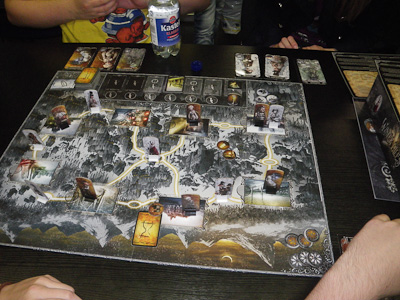 We only did one more game today. This one was Riff Raff from ZOCH and it is a pure balancing game. Like in Bamboleo players alternately have to place one of their wooden tiles (cargo) on a ship. There are several zones on the ship and the higher you raise the narrower these become. In every round each player selects one of his cards that determines in which zone the player has to place his cargo. Of course nothing must fall down, otherwise this cargo goes to the responsible player and he must load it on the ship again. The first player who is able to get rid of all of his cargo wins the game. I like this kind of games a lot. And after so many complex games, it was the best game to end the show. 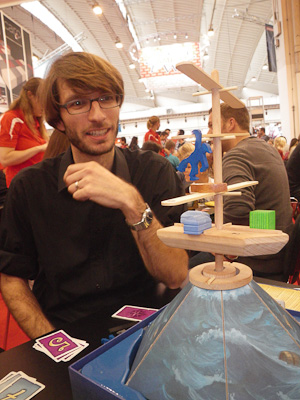 Thanks to all of you who have followed our coverage. As far as I am concerned, I am going to have some rest. No more games for this week, but I will be back in a short time. Until then I say goodbye and goodnight. |
Without Ralf I never would have been able to cover the SPIEL with such a breadth, so I am rather grateful that he has moved back to Essen which allows him to assist me with his own reports. Thank you Ralf for joining me on the convention floors!
However, as promised the day was not yet over for Nicole and me, and so we continued our trip into the great unknown, meaning that I once again did Nicole take the lead in order to discover something new! So, we ended up in Hall 4 at the booth of ILOPELI, yet another French publisher of small cardgames. Nicole actually had been attracted to this booth by the cute looking games' artwork which was displayed on big posters at the back of the booth. We ended up trying a game of Sherlock, a cooperative cardgame which uses cute character artwork of animals.
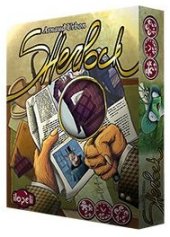 The game comes as a Memory-variant in which the players face the common goal of catching the infamous Dr. Moriaty after he has committed a crime. Six different witnesses of the crime have been found, and for each witness a set of five cards exists, with each of the five cards showing one of the five different accomplices of Dr. Moriaty. During setup, all 30 witness cards are placed face-down on the table, so that only the backsides which show the different witnesses are shown to the players.
The game comes as a Memory-variant in which the players face the common goal of catching the infamous Dr. Moriaty after he has committed a crime. Six different witnesses of the crime have been found, and for each witness a set of five cards exists, with each of the five cards showing one of the five different accomplices of Dr. Moriaty. During setup, all 30 witness cards are placed face-down on the table, so that only the backsides which show the different witnesses are shown to the players.
During his turn, a player now may start to reveal cards, as long as he reveals cards which will show the same accomplice of Moriaty. If three cards showing the same accomplice can be found in a row, these cards will be removed from the game, but if the player is not successful finding three identical cards all the cards will be turned face-down once again, and one of ten Moriaty-cards will be revealed. These cards have no specific functions apart from showing Moriaty on the run to reach the airport, and if the tenth card is revealed due to the tenth failure of the players, the timer simulated by these cards ends and the players will have lost the game.
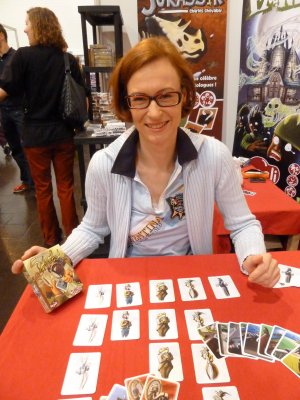
So, the players only can afford to make nine mistakes, a seemingly quite low amount considering that 30 cards must be searched to find the triples. However, you must consider the fact that the players know the cards backsides which sow the different witnesses, and they likewise know that each deck of five witness cards contains one card of each accomplice. Thus, after revealing some first cards the players can start to make deductions which witness cards still may feature matching accomplices, and so the game slowly turns to challenge the players with a nice deduction task.
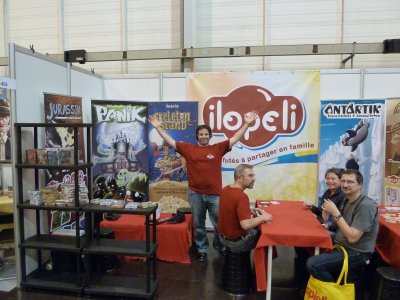
With the noise and warmth of the convention halls surrounding us, Nicole and I missed the final set of cards which would have been needed to fully solve the puzzle, but nonetheless this cute little game with its nice illustrations was pocketed and went home with us!
Nicole and I also would have liked to play a round of SPELLBOUND at the FRAGOR booth, but unfortunately we were out of luck here. We didn't get a possibility to play, but since we had already explored the components of our copy of Spellbound back at home we watched a bit of the other people's game, and so I still would like to take this opportunity to present you with a first opinion on Spellbound.
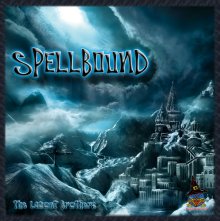 It's always a challenge for a reviewer to embark on the mission to write a text about a new FRAGOR-game because the Lamont brothers show a rather irritating tendency to come up with quite unusual playing concepts. Here their newest creation Spellbound is not different from its wacky predecessors, since the mechanisms assembled in Spellbound once again form a quite innovative playing experience.
It's always a challenge for a reviewer to embark on the mission to write a text about a new FRAGOR-game because the Lamont brothers show a rather irritating tendency to come up with quite unusual playing concepts. Here their newest creation Spellbound is not different from its wacky predecessors, since the mechanisms assembled in Spellbound once again form a quite innovative playing experience.
First off, the background story: Several wizard apprentices (the players) totally overestimated their powers, and they challenged an evil Witch to a spellcasting duel. The outcome was as predictable as it was horrible, and so the players were changed into ugly gremlins with huge hands and noses. Now they have to roam the land in search of at least four of the five most ancient spellbooks, since they will need these spellbooks to face the Witch to a final duel in order to regain their former (handsome?) looks.
On the gameboard the players will find four different cities and a stretch of wilderness, and within each of these regions there is a track on which one of the five spellbooks is placed. However, behind each spellbook on each track a pursuer is placed (a Troll in the wilderness, Witch Hats in the cities), and whenever a pursuer is able to catch up with a spellbook, the book will be lost and is removed from play. So, it will be the aim of the players to move the spellbooks forwards until they reach the end of their tracks where they can be collected by a player who is present in this region.
The mechanism on which the gameplay is built uses a deck of Destiny cards which is available to all players. This deck includes both cards which are useful for the players (Mage cards) and cards with detrimental effects (Wicked cards), but in total the number of simple but helpful Mage cards is higher. Following a variant of a modern deckbuilding-mechanism, the players will try to add Mage cards to the deck, whereas the mechanisms of the game will force them to add Wicked cards as well, and when they are drawn from the deck these Wicked cards usually trigger a movement the pursuers of the spellbooks.
At the beginning of the game and at the end of each player's turn cards are drawn from the Destiny deck until a total of five Mage cards has been revealed and placed next to the deck to form the Destiny display. During this refreshment of the Destiny-display some Wicked cards will appear as well, and whenever a Wicked card appears the corresponding pursuer (Troll or a specific Witch Hat) is moved one step on his track. Provided this revealing of new cards does not cause the loss of a second spellbook, it will now be the active player's turn, and he may use or discard as many of the Mage cards as he desires. Up to two unused Mage cards may be left in the display, so that - when the display is replenished at the end of the player's turn - only three more Mage cards need to be revealed in order to refill the display for the next player's turn.
The different Mage cards available at the beginning of the game can be used to gain one movement, one use of magic or one influence for recruiting allies, and alternatively each of these card types also may be used for triggering one step of movement of a specific spellbook. However - and here the problems start - a spellbook cannot simply be moved by choosing a corresponding Mage card, but instead the active player also needs to be in the corresponding city (or in the wilderness) with his character. Thus, the movement action is needed to move player characters between the different regions. In addition, a total of 12 different villages also exists, with each village forming a region to which the players can travel. During game setup, nine of these villages were assigned random decks of ally cards, whereas the other three villages contain special locations (the Witch's Tower among them). The content of each village only is revealed upon the first visit of a player, and apart from the fact that the players need to recruit allies to strengthen the deck of Destiny cards they also need to discover the Witch's Tower because the final battle is fought there.
Talking about allies, they can be recruited by a player using Influence cards in the village where the desired ally deck is located (with the possibility to save up played influence to recruit more costly allies). The game contains 16 different decks of ally cards (Knight, Dragon, Dark Elf etc), and whenever the players are able to recruit a card from one of the ally decks the recruited card will be placed at the discard pile of the Destiny deck in order to be shuffled into the Destiny deck upon the next re-shuffling. If, at a later point the Destiny display is replenished and an ally is revealed, the ally effectively serves as a Mage card, giving the active player the possibility to use his powers. As a rule, all different allies have stronger positive effects than the basic Mage cards which are included in the Destiny deck at the beginning of the game, and the abilities of the allies can range from allowing multiple actions to special abilities which allow new kinds of actions. As can be seen, this element of Spellbound is close to other deckbuilding games, since the players have a number of special decks available which they can use to construct their common Destiny deck.
However, the uses of the cards from the Destiny deck are more intricate than the simple possibility to use them for actions and for triggering movements of the pursuers of the Spellbooks. Upon each exhaustion of the Destiny deck (and during the final battle) the players will have to face the evil Witch in a duel, and the strength of both the players and the Witch depends on a number of factors. Here it becomes important that each player starts his turn by placing one of the Destiny cards from the display into the Witch's Tower space, and he may choose either a Mage card (including allies) or a Wicked card for this placement. Such a placement lasts until the cards are returned to the deck after a duel, and Wicked cards placed in the Tower will increase the Witch's strength in the upcoming battle, whereas Mage cards will increase the players' strength. If a Mage card or ally is chosen, this card will not be available for a normal action, and so the strength value of these cards is higher if they would otherwise allow a more powerful action.
In addition, the game features an opaque bag containing Sunstones (amber) and Moonstones (blue). At the beginning of the game three Sunstones and two Moonstones were placed in this bag, and more stones may be added by game effects. When it comes to a battle against the Witch, stones are drawn from the bag corresponding to the Witch's current position within her Tower, and the amount of drawn Sunstones is added to the players' strength, whereas drawn Moonstones will strengthen the Witch. In a way, the mechanics around this bag remind a bit of 1960: The Making of the President from Z-MAN GAMES, since the players need to "feed" the bag with Sunstones in order to increase their chances. In addition, the bag is also used when a player decides to use a card with a magic-action while in a city, because the player then has to draw a stone from the bag, and if a Sunstone is drawn the pursuer in that city will be moved one space backwards.
But returning the battle against the Witch, the battle outcome has not yet been determined. If the Witch's strength equals or is higher than the strength of the players, the Witch wins and is moved one or more steps upwards in her Tower (with the number of steps depending on the difference between both strength values). If the Witch moves in the Tower, she will trigger detrimental effects like the adding of new Wicked cards to the Destiny deck, and in addition more stones will be drawn from the bag during the following battles. The game even may come to an early end through such a Witch movement, since all will be lost if she reaches the top of her tower and declared total domination of the whole realm.
If the players win a battle, the Witch will stay in place and the players will be allowed to move one spellbook one step forwards. However, the unforgiving Witch will take revenge on the players, and so she will summon her weakest available Minion card which now will add to her strength in the following battles. As a result of being beaten several times, the Witch may activate up to three (permanent) Minion cards which may add a total of 12 points to the Witch's strength (gulp!).
If the players were able to get four of the five spellbooks from the cities and the wilderness by moving the books to the ends of their tracks, they must meet in the village where the card of the Witch's Tower was discovered in order to trigger the final battle. This battle is fought as usual, with the specialty that the spellbooks now either increase the players' strength by one for each spellbook, or they can be used to destroy Wicked cards and Minions. In effect, the players now usually will remove the most powerful of these cards, because they need to reduce the Witch's strength as much as they can. Since the spellbooks only can be used in the final battle this may result in the situation that the Witch's strength now is considerably lower than in the last "normal" battle because her most powerful cards can be removed by the spellbooks, and this situation comes a bit unexpected because you would expect the final battle to be the toughest one.
However, despite this sideline observation the pressure on the players is considerable, and even though early victories against the Witch may buy some time, the players cannot really afford to waste many of their actions. As each victory against the Witch will trigger the appearance of a Minion, the players only can tackle the problem head on, and so they will need to gather the spellbooks quickly while at the same time not neglecting to build up enough strength to face the Witch. Good timing is quite essential for this, since it could prove disastrous if the players collect four spellbooks, but then are challenged to a duel with the Witch and her Minions because they have failed to meet it in the village containing the Witch Tower. Still the players are not without their own resources, and so they can gain helpful Spell cards and charge their wands with valuable bonus actions. All this may help them against the evil Witch!
The outline given above has left out quite a few details of the full rules, but nonetheless it should be enough to give a general impression of the game's mechanics. Although the Lamont brothers couldn't resist to include the one or other pun in the rulebook, the game presents itself as a very mature and well-thought-out final product. At first contact I was having some doubts whether the different extra mechanics like the opaque bag and a movement related gameboard would fit well with a deck building mechanism, but gameplay revealed that these factors come together in a quite harmonious way. Even better, the game actually uses the deckbuilding mechanics on a common deck in order to implement cooperative gameplay, and seeing the ever-growing number of deckbuilding games where each player builds his own deck it comes as a refreshing variant that Spellbound challenges the players to participate in the building of a joint deck. Of course, like all cooperative games Spellbound also faces a possible Wisenheimer-problem because one player may try to dominate the others, and so each player should try to focus on the actions of their particular character, thus giving everybody ample of room to do their own thing.

Finally, and that's the trademark of almost every FRAGOR-game, Spellbound once again contains a gorgeous set of playing figures, consisting of the four player "Gremlins", the Witch, her Hats, the Troll, a City guard and five different spellbooks. The figures correspond quite well with the design of the gameboard and the somewhat comical artwork found on the Ally cards, and apart from the interesting rules these great components once again contribute to make the game a real head-turner!
However, after this outline let's directly continue with today's playtesting, because there is still two more games which I would like to cover. After yesterday's Room 25 and Kemet on friday, I led Nicole once again to the booth of MATAGOT because there was still one more new game available there from which I suspected that Nicole might like it. Indeed, upon seeing the big demonstration table featuring River Dragons Nicole instantly wanted to give it a try, and indeed we once again were lucky to join a just beginning round of play.
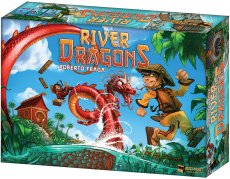 Roberto Fraga's game River Dragons challenges the players to participate in a dangerous race in the Mekong delta, running over planks bridging the river and hoping not to be hampered by the mighty River Dragons. The gameboard features a total of 6 small islands which are distributed equally around its outer edge, and on each of these islands the figure of one of the up to six players will begin the game. It will be the aim of each player to reach the opposite island, and for this purpose first stones must be placed on sandbanks within the river, and afterwards planks can be placed on the stones to allow the passage of the player figures.
Roberto Fraga's game River Dragons challenges the players to participate in a dangerous race in the Mekong delta, running over planks bridging the river and hoping not to be hampered by the mighty River Dragons. The gameboard features a total of 6 small islands which are distributed equally around its outer edge, and on each of these islands the figure of one of the up to six players will begin the game. It will be the aim of each player to reach the opposite island, and for this purpose first stones must be placed on sandbanks within the river, and afterwards planks can be placed on the stones to allow the passage of the player figures.
Each player possesses a set of six planks of different lengths which can be placed, but actions may not be taken at random but instead each player has to "program" the five actions his character will take during the upcoming round of play. The programming-mechanism is similar to Roborally, with each of the players possessing a deck of action cards from which five cards must be chosen and placed face down in front of the player in an order in which the player desires to perform the actions. However, when everybody is ready, the players will take turns performing one action each, so that first all players will perform their first action before everybody performs their second action etc.
The action cards rank from the placement of one or two stones to the placement of one or two planks from the players' stockpiles, but when placing a plank the players need to make a good estimation which length may be needed, because a plank which is too short to bridge the desired gap between one stone and another will drop into the water and is removed from the game. Of course, the players also may use movement action cards to move their character for one or two planks, but here the tricky part begins. Each player wants to move out quickly, but with the planks criss-crossing each other in the middle of the river it will be unavoidable to run over planks placed by opposing players. However, only one figure may stand on each plank, and so the player figures will be blocking each other. Even the placement of additional planks to circumvent this may not be possible because no more than three planks may end on one stone, and so it may happen that a player must use his programmed movement action to move his character backwards, or - even worse - if the character cannot move at all the character falls off the plank and must restart his race on his own home island. A jumping action may be used to get over a blocking character, but using this card may be dangerous because the card only will work if there still is a blocking character which can be jumped. If the character has moved out of the way before the jumping action comes to bear, the character who wanted to make the jump once again lands in the water and must be returned to his island of origin.
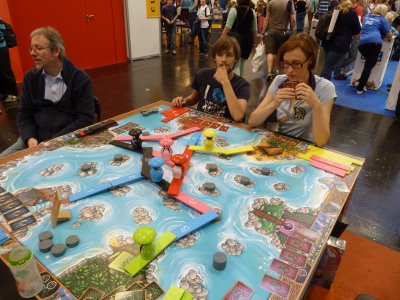
In addition to the cards already mentioned, the players also possess two types of cards which may be used to hamper other characters. One card may be used to take back a stone or a plank from the gameboard, and in case of a plank the plank even may originally come from another player, provided that the plank is not occupied by any character and that the taking player does not have a plank of identical length in his stockpile. This taking back of a plank may result in nasty surprises, and so a player may find his figure facing a gap which had not been there some seconds ago.
The other kinds of obstacle are the aforementioned River Dragons. A player's set of action cards contains one River Dragon in the colour of each opposing player, and a player may place one of these River Dragon cards as one of his five programmed action cards. When the dragon is revealed, the player who is matching the colour of this particular River Dragon is not allowed to perform his current action, and this once again may result in a planning disaster which may end with an involuntary swimming lesson.
As you can see, River Dragons is a game where several playing skills come together. On the one hand you have an element of speculation, trying to forsee which cards will be used by your opponents in order to find a proper programming for your own character. On the other hand, the players also will need an eye for measures, since nothing is more unnerving than seeing a much needed plank go down the river because it was too short. Already these elements provide for a quite entertaining game, but it will get even more interesting when the players have played one or two games of River Dragons and begin to see the developments on the whole gameboard. Due to the rhythm of each player performing one action, several factors need to be considered especially when some characters meet in the center of the board, and here a bit of experience helps to prevent an unforeseen breakthrough of a character. All these elements make River Dragons a rather enjoyable family game, and Nicole and I had quite a bit of fun playtesting the game here at the SPIEL.
Well, this brings me close to the end of this last day at the SPIEL '12, since around 4 PM Nicole and I started visiting some booths to say goodbyes to our friends. However, on this tour we also went through the remote Hall 7 which we had not visited yet, and here we stumbled upon a small booth which displayed some interesting posters in the background. The graphics suggested that the game Proxy Wars would be dealing with conflicts between the industry and green activists, and since this theme actually interested both Nicole and me we approached the booth to learn more about the game.

Designed as a 2-player game, Proxy Wars comes packed in small card-boxes which contain each of the player factions - the green activists of GREEN ENGAGE and the industrialists of Megalith Corporations Unlimited, short MEGACORP. Each of these card boxes contains a handful of nicely illustrated cards plus some wooden agents-tokens which are needed to play the game. In addition, here at the SPIEL both boxes were sold in a bundle with the OATH BOUND expansion set, featuring some additional cards for both factions and again some wooden tokens.
The two factions face each other in a competition to decide about the future of our planet, with the green activists trying to protect nature, whereas the industry demands that industrial growth always must be ascertained. However, in this game it's not a contest of words, but instead both factions fight each other using agents. Thus, it is the aim of the game to capture some agents of the other player in order to possess more active agents plus victory points than the opponent.
Each player plays with his own set of faction cards, but instead a drafting process the players just take their sets of action cards onto their hands and play with all of their cards available right from the beginning. During their turns, the players may place cards from their hand onto the table, and by placing new cards they will build the "gameboard" on which the game is played.

Instead of playing a new card onto the table, a player also may opt to bring one of his agents (a wooden token) into play, provided that he already has placed at least one recruitment card on which agents may be placed. These agents then may be moved (yet another action) to occupy other cards, and each player will have to place agents on his cards in order to use their special abilities. If agents of two players are on adjacent cards, the active player may try to capture the other agent with his own agent. For this purpose he needs to be standing on a card providing him with an attack value, whereas the attacked agent only can defend himself successfully if he is standing on a card with a defence value as high as the attack value of the attacking agent.
However, the abilities of the different cards are not limited to providing attack and defence capabilities, but instead the cards of each player offer various special functions which can be triggered if they are occupied by an agent. These special functions differ between both factions, and sometimes they may even be used to influence the outcome of an attack.
Due to Nicole and me being a bit exhausted, we failed to go through a full game of Proxy Wars because it was a bit difficult to get a grip of the different special abilities in each card deck, especially since the cards are not just used from a player's hand, but instead they must be used to enlarge the gameboard and manned with agents in order to giver their effect. However, we both agreed that the mechanism which combines the stepwise building the gameboard with the recruitment and use of the agents offers an interesting challenge which we both wanted to explore. So, we ended up with a Proxy Wars bundle in our pockets.
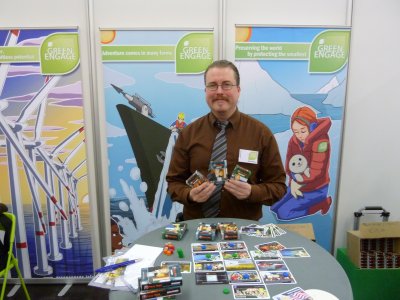
However, it's not just the theme which actually interested us about the game. Despite the fact that all cards only feature English text, Proxy Wars actually is produced by a German company, and author Roland Weininger told us a bit more about the ebackground of the game. So, he has some real developments have found their way into the game, whereas all the purely fictional personalities have been given appearances in social media like Twitter and Facebook. Even the two factions have their own websites (which are still under development), and so Mr. Weininger is trying to blur the boundaries between reality and game fiction. A quite interesting approach to market the game.
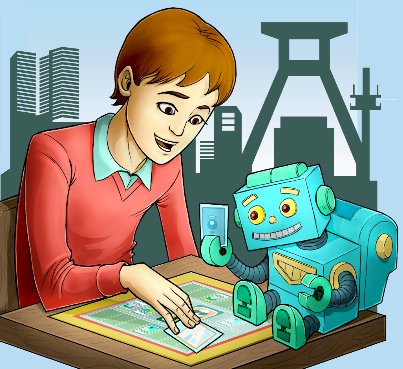
Quite interestingly, Nicole and I also learned that Mr. Weininger is the organizer of the Essen Warm-up Day, an event which happened on wednesday and to which all international gamers arriving for the SPIEL were invited. Happening at a central place here at Essen, international gamers who have registered for the event will be welcomed with some games to test and free food and drinks for the whole day. So, if you should plan to visit the SPIEL in the future and if you want to learn more about this event, please visit the website of the Essen Warm-up day!
After this rather interesting chance meeting Nicole and I finished our round through the halls, and afterwards we left for home - happy but exhausted. One of the last things I did at the SPIEL was checking out the final results of the Fairplay Scout polling and the Geekbuzz ratings, and I was once again amused to see that many of the games I have covered in the previous days failed to make it into the top 15 of Fairplay. Only Tzolk'in: The Mayan Calendar (7th place) and Legends of Andor (8th place) could be found there. The situation is a bit different in the GeekBuzz ratings which are more important for international gamers, but overall I was glad to see that once again I have succeeded in presenting you some off-mainstream games.
And as all good things must come to an end, I have also reached the end of this year's SPIEL coverage. Well, not quite yet…
I still owe you a farewell gift which will complete this year's Convention Giveaway, and after delaying it for such a long time I now would like to present to you the brand-new Sirens of Belshar player tableau for Ryan Laukat's great Empires of the Void boardgame. Please remember that the planet Belshar was included in tursday's report, and you will need to print both files in order to use the Sirens!
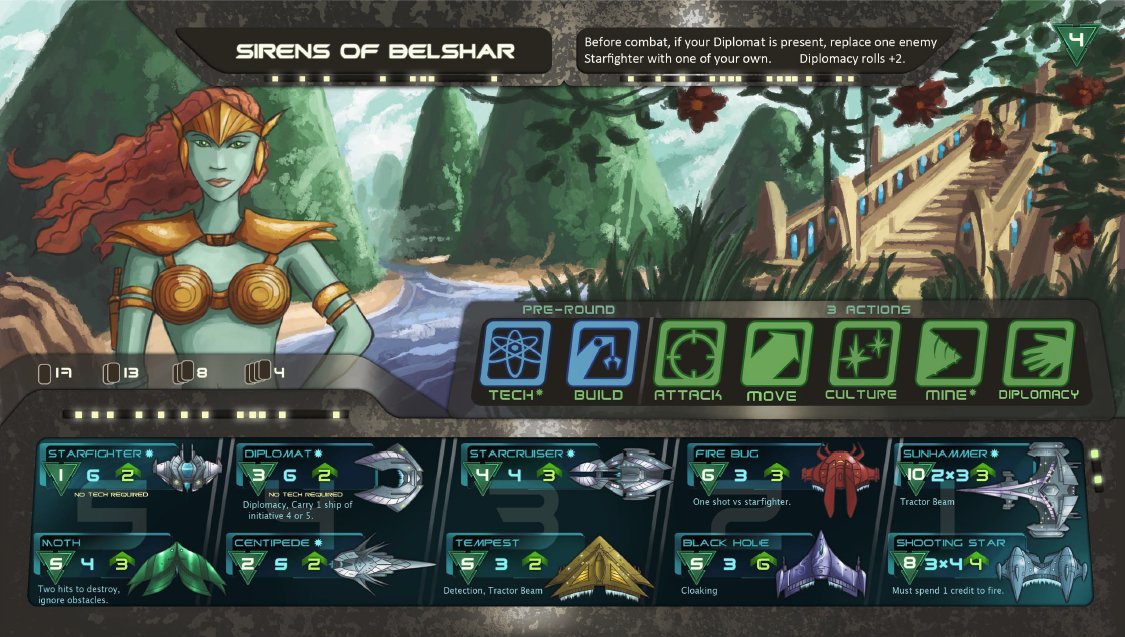
The special ability of the Sirens basically means that they may steal a Starfighter from an opposing player in a space battle, provided that at least one Siren Diplomat ship is present in this battle and the Sirens have an unused Starfighter ship available. If these two conditions are met, the opposing Starfighter is removed and handed back to its owner, whereas the additional Starfighter of the Sirens is placed at the same space and - of course - participates in the battle on side of the Sirens.
With the Gamebox Convention Giveaway being completed, the traditional last step of my convention coverage is the announcement of my personal convention hit, and I must admit that I am hard pressed this time to give the game to one particular game.
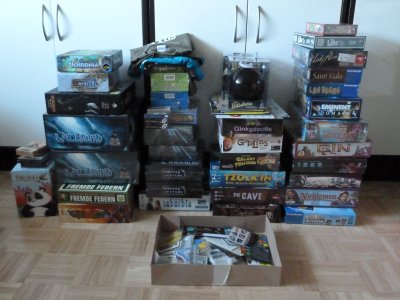
I rather liked quite a few of the games which I was able to play, and due to the different orientations of most of these games it's really difficult to single out one particular game. City of Horror, Kemet, Robinson Crusoe: Adventure on the Cursed Island, 1969, Briefcase, Fremde Federn, Legends of Andor and Tzolk'in: The Mayan Calendar all rank more or less equally high for me, and if you want to understand my problem you just need to look at the stack of games which has grown at my home during this SPIEL. However, not wanting to break with tradition, I will nonetheless make the announcement of…

I will give my special recommendation this year to Tzolk'in: The Mayan Calendar, because I think that it is a real gamer's game which should not be skipped by any player with a liking for strategy games. Even though the players will need to get used to the mechanism of the gears, the game seems rather well balanced without advantaging any of the players. There are plenty of options available, and even the question how the players should start into the game is solved in a quite elegant way, because the players do not receive a fixed amount of starting resources or something similar, but instead each player secretly chooses two out of four stating tiles which will give him access to a number of small benefits right for the beginning of the game. All this contributes to a great playing experience right from the beginning!
With all loose strings tied up, you are the last people to whom I will bid farewell from this year's SPIEL! Once again it has been great fun for me to scout the convention halls in search of great games and bits of news, and looking through my guestbook I see that many of you have enjoyed my reports for many years now. I am honoured that you have been following my steps for such a long time, and I am glad that you found the time to leave some messages for me in the guestbook. As you might guess, it takes a lot of determination to take this whole reporting operation going for one week, and so your feedback is the confirmation I need to go on with it each year!
During the following week the prize draw still will be open, and I will be returning to my office in order to see which kinds of tax problems have found their way onto my desk. However, I will take a lot of fond memories with me from this year's great SPIEL, and I hope to meet you all back here in 2013!!!
Same time, same place!!!
Frank Schulte-Kulkmann
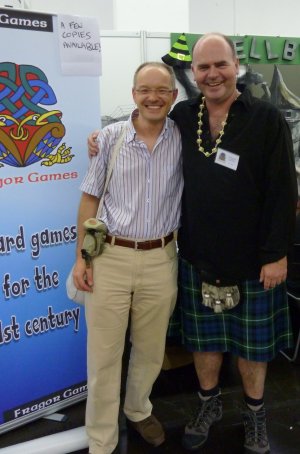
You can also go by train to Essen Central Station. If arriving there, go to the basement and take the Subway U11 directly to the Messe Essen.
If you want to arrange lodging at Essen, you best contact the Essen-tourism-center by phone 0049/(0)201/19433 or 0049/(0)201/88720-46 or -48. Perhaps they know where some Hotel-rooms are left...
If you travel to Essen by car, please notice that Germany restricts access to many cities (including Essen) for older cars. While the convention area does not fall under these environmental restrictions if you follow a specific route, you might want to check out the route details at the official Messe Essen website. An even better alternative (especially for those of you having a hotel in Essen) would be the acquiring of an Envirnomental Badge which can be ordered at the offical website of the German Technical Inspection Authority.
If you want to have a look at my coverage of previous conventions, follow these links. But you should bring along some time, especially of you want to read the younger reports...
|
| ||

|
|

|
|
| ||
|
Kulkmann@aol.com
Copyright © 2011 Frank Schulte-Kulkmann, Essen, Germany | ||